Essay on New Education Policy 2020
500+ words essay on new education policy 2020.
Education is a fundamental need and right of everyone now. In order to achieve our goals and help develop a just society, we need education. Similarly, education plays a great role in the national development of a nation. As we are facing a major change in terms of knowledge globally, the Government of India approved the National Education Policy 2020. This essay on new education policy 2020 will help you learn how this new policy has replaced the National Education Policy 1986 that is 34 years old.


Aim of the New Education Policy 2020
This new policy has the aim of universalizing education from pre-school to secondary level. It plans to do that with a 100% GRE (Gross Enrollment Ratio) in schooling. The plan is to achieve it by 2030.
This essay on new education policy 2020 will highlight the changes brought in by this new policy. Firstly, the policy proposes to open Indian higher education in foreign universities.
It aims to introduce a four-year multidisciplinary undergraduate program with various exit options. Thus, this new policy will strive to make the country of India a global knowledge superpower.
Similarly, it also aims to make all universities and colleges multi-disciplinary by the year 2040. Finally, the policy aims to grow employment in India and also bring fundamental changes to the present educational system.
Get the huge list of more than 500 Essay Topics and Ideas
Advantages and Disadvantages of New Education Policy 2020
The policy gives an advantage to students of classes 10 and 12 by making the board exams easier. In other words, it plans to test the core competencies instead of mere memorization of facts.
It will allow all the students to take the exam twice. Further, it proposes that an independent authority will be responsible for regulating both public and private schools . Similarly, the policy aims to diminish any severe separation between the educational streams and vocational streams in the schools.
There will also be no rigid division between extra-curriculum. Vocational education will begin at class sixth with an internship. Now, the essay on new education policy 2020 will tell you about the disadvantages of the policy.
Firstly, it can make the education system expensive. Meaning to say, admission to foreign universities will probably result in this. Further, it will create a lack of human resources.
If we look at the present elementary education, we notice that there is a lack of skilled teachers. Thus, keeping this in mind, the National Education Policy 2020 can give rise to practical problems in implementing the system that is for elementary education.
Finally, there is also the drawback of the exodus of teachers. In other words, admission to foreign universities will ultimately result in our skilled teachers migrating to those universities.
To conclude the essay on New Education Policy 2020, we can say that this policy is an essential initiative to help in the all-around development of our society and country as a whole. However, the implementation of this policy will greatly determine its success. Nonetheless, with a youth dominant population, India can truly achieve a better state with the proper implementation of this education policy.
FAQ of Essay on New Education Policy 2020
Question 1: What does the New Education Policy 2020 aim to achieve by 2030?
Answer 1: This new policy has the aim of universalizing education from pre-school to secondary level. It plans to do that with a 100% GRE (Gross Enrollment Ratio) in schooling. The plan is to achieve it by 2030.
Question 2: Give two challenges the New Education Policy 2020 may face?
Answer 2: Firstly, it can make the education system expensive. Meaning to say, admission to foreign universities will probably result in this. Further, it will create a lack of human resources.
Customize your course in 30 seconds
Which class are you in.

- Travelling Essay
- Picnic Essay
- Our Country Essay
- My Parents Essay
- Essay on Favourite Personality
- Essay on Memorable Day of My Life
- Essay on Knowledge is Power
- Essay on Gurpurab
- Essay on My Favourite Season
- Essay on Types of Sports
Leave a Reply Cancel reply
Your email address will not be published. Required fields are marked *
Download the App

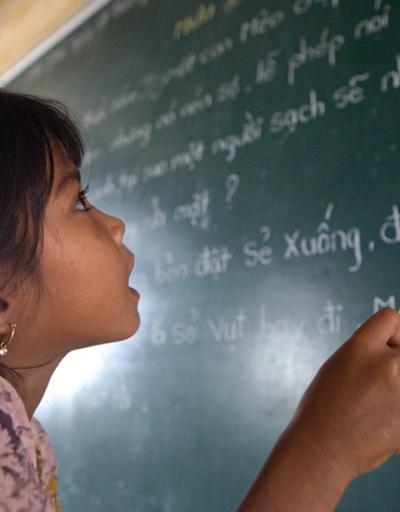
Education policies and strategies
Education is a complex system with many interconnected subsystems and stakeholders. Any decision taken on one component at one level of education brings change to other components and subsystems. This interconnectedness requires policy and decision-makers to ensure that coherent and consistent education policy and strategic frameworks are in place from a sector and system perspective. Emerging challenges such as rapid digitalization, increasing inequality and disruptions caused by climate change, pandemics and conflicts, demand that countries develop resilient and sustainable policies and strategies on which to build efficient, relevant and transformative education systems.
What you need to know about education policies and strategies
Education is one of the largest public sectors often taking up 15-20% of a government's total budget and employing many teachers as civil servants. All education sub-sectors (from early childhood to higher education and beyond) as well as different elements of education (e.g. teachers, curriculum, pedagogy, and assessment) must work in sync to support a learner’s lifelong and life-wide learning, as well as their successful social and economic integration. Therefore, education ministries need to define coherently and systemically what the system should achieve, the policy priorities and strategies to deploy to implement that vision and development options and actions that are executable, measurable and accountable. In countries with several ministries in charge of the education and training sector, developing sector-wide education policies and programmes can help overcome incoherence and the development of different plans in isolation that can often contradict one another.
Supporting countries to build and improve their education systems to meet the needs of a changing world is at the core of UNESCO’s work. At the global level, UNESCO develops and advocates for public goods to enable strategic policy-making. These include SimuED, an education sector simulation model that can help countries to develop forward-looking yet feasible education policies and strategies.
UNESCO helps governments to strengthen legal and policy frameworks in relation to education systems as well as improving management efficiency and accountability, financing, data collection and analysis and learning assessment, all with the targets of the 2030 Agenda in view. This is part of UNESCO's rights-based approach to education with States having the main responsibility to respect, protect and fulfil the right to quality education for all throughout life and is carried out through education policy reviews and other technical and capacity development support.
UNESCO also emphasizes the importance of happiness in education as the foundation for better learning. Its Happy Schools Project aims to improve learning experiences by focusing on well-being, engagement, a sense of belonging at school, and helps foster a lifelong love of learning. The project targets the happiness of the school rather than individual students because schools are sites of holistic, sustainable community development that include teachers, parents, staff and school leaders. Faced with many crises and challenges, schools around the world are struggling to determine how to support teachers, learners, and communities while also prioritizing supplemental learning. The project emphasizes that schools can be powerful places to combat the negativity that stunts learning, both cognitive and non-cognitive.
Upon request from countries, UNESCO undertakes activities according to the country’s needs which may start with an education policy review or supporting the development of education sector policies and plans. It also promotes policy dialogue and debate based on evidence and insights drawn from analytical work and research. Working mainly through its institutes such as its International Institute for Educational Planning (IIEP) , UNESCO helps to build national capacities on developing and implementing education policies to realize the country’s education and national development visions.
Strengthening the resilience, quality and equity of education systems
A framework to support governments to position school happiness as a key target
through UNESCO International Institute for Educational Planning
was allocated to education and training during the pandemic
spend below international benchmarks for public education spending
achieved international target of allocating 0.7% of GNI to official development assistance
highlighted the need to support psycho-social and mental well-being of students and teachers
Education policy working papers
This series documents experiences of countries in the area of education policy development and system strengthening.

Planipolis, by UNESCO International Institute for Educational Planning
Planipolis is a portal of national education plans and policies, key education frameworks and monitoring report. It provides a single entry to official education resources for national policy makers, donors and partners.
Have you met Malia? She explains why educational planning is the backbone of stronger, more resilient, and quality-focused education systems. Educational planning is also a key to her attaining all of her dreams and aspirations.

Publications

Monitoring SDG 4: education finance
Resources from UNESCO’s Global Education Monitoring Report.
What education policy experts are watching for in 2022
Subscribe to the brown center on education policy newsletter, daphna bassok , daphna bassok nonresident senior fellow - governance studies , brown center on education policy @daphnabassok stephanie riegg cellini , stephanie riegg cellini nonresident senior fellow - governance studies , brown center on education policy michael hansen , michael hansen senior fellow - brown center on education policy , the herman and george r. brown chair - governance studies @drmikehansen douglas n. harris , douglas n. harris nonresident senior fellow - governance studies , brown center on education policy , professor and chair, department of economics - tulane university @douglasharris99 jon valant , and jon valant director - brown center on education policy , senior fellow - governance studies @jonvalant kenneth k. wong kenneth k. wong nonresident senior fellow - governance studies , brown center on education policy.
January 7, 2022
Entering 2022, the world of education policy and practice is at a turning point. The ongoing coronavirus pandemic continues to disrupt the day-to-day learning for children across the nation, bringing anxiety and uncertainty to yet another year. Contentious school-board meetings attract headlines as controversy swirls around critical race theory and transgender students’ rights. The looming midterm elections threaten to upend the balance of power in Washington, with serious implications for the federal education landscape. All of these issues—and many more—will have a tremendous impact on students, teachers, families, and American society as a whole; whether that impact is positive or negative remains to be seen.
Below, experts from the Brown Center on Education Policy identify the education stories that they’ll be following in 2022, providing analysis on how these issues could shape the learning landscape for the next 12 months—and possibly well into the future.

I will also be watching the Department of Education’s negotiated rulemaking sessions and following any subsequent regulatory changes to federal student-aid programs. I expect to see changes to income-driven repayment plans and will be monitoring debates over regulations governing institutional and programmatic eligibility for federal student-loan programs. Notably, the Department of Education will be re-evaluating Gainful Employment regulations—put in place by the Obama administration and rescinded by the Trump administration—which tied eligibility for federal funding to graduates’ earnings and debt.

But the biggest and most concerning hole has been in the substitute teacher force —and the ripple effects on school communities have been broad and deep. Based on personal communications with Nicola Soares, president of Kelly Education , the largest education staffing provider in the country, the pandemic is exacerbating several problematic trends that have been quietly simmering for years. These are: (1) a growing reliance on long-term substitutes to fill permanent teacher positions; (2) a shrinking supply of qualified individuals willing to fill short-term substitute vacancies; and, (3) steadily declining fill rates for schools’ substitute requests. Many schools in high-need settings have long faced challenges with adequate, reliable substitutes, and the pandemic has turned these localized trouble spots into a widespread catastrophe. Though federal pandemic-relief funds could be used to meet the short-term weakness in the substitute labor market (and mainline teacher compensation, too ), this is an area where we sorely need more research and policy solutions for a permanent fix.

First, what’s to come of the vaccine for ages 0-4? This is now the main impediment to resuming in-person activity. This is the only large group that currently cannot be vaccinated. Also, outbreaks are triggering day-care closures, which has a significant impact on parents (especially mothers), including teachers and other school staff.
Second, will schools (and day cares) require the vaccine for the fall of 2022? Kudos to my hometown of New Orleans, which still appears to be the nation’s only district to require vaccination. Schools normally require a wide variety of other vaccines, and the COVID-19 vaccines are very effective. However, this issue is unfortunately going to trigger a new round of intense political conflict and opposition that will likely delay the end of the pandemic.
Third, will we start to see signs of permanent changes in schooling a result of COVID-19? In a previous post on this blog, I proposed some possibilities. There are some real opportunities before us, but whether we can take advantage of them depends on the first two questions. We can’t know about these long-term effects on schooling until we address the COVID-19 crisis so that people get beyond survival mode and start planning and looking ahead again. I’m hopeful, though not especially optimistic, that we’ll start to see this during 2022.

The CTC and universal pre-K top my list for 2022, but it’s a long list. I’ll also be watching the Supreme Court’s ruling on vouchers in Carson v. Makin , how issues like critical race theory and detracking play into the 2022 elections, and whether we start to see more signs of school/district innovation in response to COVID-19 and the recovery funds that followed.

Electoral dynamics will affect several important issues: the selection of state superintendents; the use of American Rescue Plan funds; the management of safe return to in-person learning for students; the integration of racial justice and diversity into curriculum; the growth of charter schools; and, above all, the extent to which education issues are leveraged to polarize rather than heal the growing divisions among the American public.
Early Childhood Education Education Policy Higher Education
Governance Studies
Brown Center on Education Policy
Ariell Bertrand, Melissa Arnold Lyon, Rebecca Jacobsen
April 18, 2024
Modupe (Mo) Olateju, Grace Cannon
April 15, 2024
Phillip Levine
April 12, 2024
- Search Menu
- Advance articles
- Featured articles
- Virtual Issues
- Prize-Winning Articles
- Browse content in A - General Economics and Teaching
- Browse content in A1 - General Economics
- A11 - Role of Economics; Role of Economists; Market for Economists
- A12 - Relation of Economics to Other Disciplines
- Browse content in B - History of Economic Thought, Methodology, and Heterodox Approaches
- Browse content in B4 - Economic Methodology
- B41 - Economic Methodology
- Browse content in C - Mathematical and Quantitative Methods
- Browse content in C1 - Econometric and Statistical Methods and Methodology: General
- C10 - General
- C11 - Bayesian Analysis: General
- C12 - Hypothesis Testing: General
- C13 - Estimation: General
- C14 - Semiparametric and Nonparametric Methods: General
- C18 - Methodological Issues: General
- Browse content in C2 - Single Equation Models; Single Variables
- C22 - Time-Series Models; Dynamic Quantile Regressions; Dynamic Treatment Effect Models; Diffusion Processes
- C23 - Panel Data Models; Spatio-temporal Models
- C26 - Instrumental Variables (IV) Estimation
- Browse content in C3 - Multiple or Simultaneous Equation Models; Multiple Variables
- C31 - Cross-Sectional Models; Spatial Models; Treatment Effect Models; Quantile Regressions; Social Interaction Models
- C32 - Time-Series Models; Dynamic Quantile Regressions; Dynamic Treatment Effect Models; Diffusion Processes; State Space Models
- C33 - Panel Data Models; Spatio-temporal Models
- C36 - Instrumental Variables (IV) Estimation
- Browse content in C4 - Econometric and Statistical Methods: Special Topics
- C40 - General
- C44 - Operations Research; Statistical Decision Theory
- C45 - Neural Networks and Related Topics
- Browse content in C5 - Econometric Modeling
- C52 - Model Evaluation, Validation, and Selection
- C53 - Forecasting and Prediction Methods; Simulation Methods
- C55 - Large Data Sets: Modeling and Analysis
- Browse content in C6 - Mathematical Methods; Programming Models; Mathematical and Simulation Modeling
- C61 - Optimization Techniques; Programming Models; Dynamic Analysis
- C62 - Existence and Stability Conditions of Equilibrium
- C63 - Computational Techniques; Simulation Modeling
- Browse content in C7 - Game Theory and Bargaining Theory
- C70 - General
- C71 - Cooperative Games
- C72 - Noncooperative Games
- C73 - Stochastic and Dynamic Games; Evolutionary Games; Repeated Games
- C78 - Bargaining Theory; Matching Theory
- Browse content in C8 - Data Collection and Data Estimation Methodology; Computer Programs
- C81 - Methodology for Collecting, Estimating, and Organizing Microeconomic Data; Data Access
- Browse content in C9 - Design of Experiments
- C90 - General
- C91 - Laboratory, Individual Behavior
- C92 - Laboratory, Group Behavior
- C93 - Field Experiments
- C99 - Other
- Browse content in D - Microeconomics
- Browse content in D0 - General
- D00 - General
- D01 - Microeconomic Behavior: Underlying Principles
- D02 - Institutions: Design, Formation, Operations, and Impact
- D03 - Behavioral Microeconomics: Underlying Principles
- Browse content in D1 - Household Behavior and Family Economics
- D11 - Consumer Economics: Theory
- D12 - Consumer Economics: Empirical Analysis
- D13 - Household Production and Intrahousehold Allocation
- D14 - Household Saving; Personal Finance
- D15 - Intertemporal Household Choice: Life Cycle Models and Saving
- D18 - Consumer Protection
- Browse content in D2 - Production and Organizations
- D21 - Firm Behavior: Theory
- D22 - Firm Behavior: Empirical Analysis
- D23 - Organizational Behavior; Transaction Costs; Property Rights
- D24 - Production; Cost; Capital; Capital, Total Factor, and Multifactor Productivity; Capacity
- Browse content in D3 - Distribution
- D30 - General
- D31 - Personal Income, Wealth, and Their Distributions
- D33 - Factor Income Distribution
- Browse content in D4 - Market Structure, Pricing, and Design
- D40 - General
- D42 - Monopoly
- D43 - Oligopoly and Other Forms of Market Imperfection
- D44 - Auctions
- D47 - Market Design
- Browse content in D5 - General Equilibrium and Disequilibrium
- D50 - General
- D52 - Incomplete Markets
- Browse content in D6 - Welfare Economics
- D60 - General
- D61 - Allocative Efficiency; Cost-Benefit Analysis
- D62 - Externalities
- D63 - Equity, Justice, Inequality, and Other Normative Criteria and Measurement
- D64 - Altruism; Philanthropy
- Browse content in D7 - Analysis of Collective Decision-Making
- D70 - General
- D71 - Social Choice; Clubs; Committees; Associations
- D72 - Political Processes: Rent-seeking, Lobbying, Elections, Legislatures, and Voting Behavior
- D73 - Bureaucracy; Administrative Processes in Public Organizations; Corruption
- D74 - Conflict; Conflict Resolution; Alliances; Revolutions
- D78 - Positive Analysis of Policy Formulation and Implementation
- Browse content in D8 - Information, Knowledge, and Uncertainty
- D80 - General
- D81 - Criteria for Decision-Making under Risk and Uncertainty
- D82 - Asymmetric and Private Information; Mechanism Design
- D83 - Search; Learning; Information and Knowledge; Communication; Belief; Unawareness
- D84 - Expectations; Speculations
- D85 - Network Formation and Analysis: Theory
- D86 - Economics of Contract: Theory
- D87 - Neuroeconomics
- D89 - Other
- Browse content in D9 - Micro-Based Behavioral Economics
- D90 - General
- D91 - Role and Effects of Psychological, Emotional, Social, and Cognitive Factors on Decision Making
- D92 - Intertemporal Firm Choice, Investment, Capacity, and Financing
- Browse content in E - Macroeconomics and Monetary Economics
- Browse content in E0 - General
- E01 - Measurement and Data on National Income and Product Accounts and Wealth; Environmental Accounts
- E02 - Institutions and the Macroeconomy
- E1 - General Aggregative Models
- Browse content in E2 - Consumption, Saving, Production, Investment, Labor Markets, and Informal Economy
- E20 - General
- E21 - Consumption; Saving; Wealth
- E22 - Investment; Capital; Intangible Capital; Capacity
- E23 - Production
- E24 - Employment; Unemployment; Wages; Intergenerational Income Distribution; Aggregate Human Capital; Aggregate Labor Productivity
- E25 - Aggregate Factor Income Distribution
- E26 - Informal Economy; Underground Economy
- E27 - Forecasting and Simulation: Models and Applications
- Browse content in E3 - Prices, Business Fluctuations, and Cycles
- E30 - General
- E31 - Price Level; Inflation; Deflation
- E32 - Business Fluctuations; Cycles
- E37 - Forecasting and Simulation: Models and Applications
- Browse content in E4 - Money and Interest Rates
- E43 - Interest Rates: Determination, Term Structure, and Effects
- E44 - Financial Markets and the Macroeconomy
- Browse content in E5 - Monetary Policy, Central Banking, and the Supply of Money and Credit
- E51 - Money Supply; Credit; Money Multipliers
- E52 - Monetary Policy
- E58 - Central Banks and Their Policies
- Browse content in E6 - Macroeconomic Policy, Macroeconomic Aspects of Public Finance, and General Outlook
- E61 - Policy Objectives; Policy Designs and Consistency; Policy Coordination
- E62 - Fiscal Policy
- E63 - Comparative or Joint Analysis of Fiscal and Monetary Policy; Stabilization; Treasury Policy
- E65 - Studies of Particular Policy Episodes
- Browse content in F - International Economics
- Browse content in F0 - General
- F01 - Global Outlook
- F02 - International Economic Order and Integration
- Browse content in F1 - Trade
- F10 - General
- F11 - Neoclassical Models of Trade
- F12 - Models of Trade with Imperfect Competition and Scale Economies; Fragmentation
- F13 - Trade Policy; International Trade Organizations
- F14 - Empirical Studies of Trade
- F15 - Economic Integration
- F16 - Trade and Labor Market Interactions
- F17 - Trade Forecasting and Simulation
- Browse content in F2 - International Factor Movements and International Business
- F20 - General
- F21 - International Investment; Long-Term Capital Movements
- F22 - International Migration
- F23 - Multinational Firms; International Business
- Browse content in F3 - International Finance
- F31 - Foreign Exchange
- F32 - Current Account Adjustment; Short-Term Capital Movements
- F33 - International Monetary Arrangements and Institutions
- F34 - International Lending and Debt Problems
- F35 - Foreign Aid
- Browse content in F4 - Macroeconomic Aspects of International Trade and Finance
- F41 - Open Economy Macroeconomics
- F42 - International Policy Coordination and Transmission
- F43 - Economic Growth of Open Economies
- F45 - Macroeconomic Issues of Monetary Unions
- Browse content in F5 - International Relations, National Security, and International Political Economy
- F50 - General
- F51 - International Conflicts; Negotiations; Sanctions
- F52 - National Security; Economic Nationalism
- F55 - International Institutional Arrangements
- Browse content in F6 - Economic Impacts of Globalization
- F60 - General
- F61 - Microeconomic Impacts
- F66 - Labor
- F68 - Policy
- Browse content in G - Financial Economics
- Browse content in G0 - General
- G01 - Financial Crises
- Browse content in G1 - General Financial Markets
- G10 - General
- G11 - Portfolio Choice; Investment Decisions
- G12 - Asset Pricing; Trading volume; Bond Interest Rates
- G15 - International Financial Markets
- Browse content in G2 - Financial Institutions and Services
- G20 - General
- G21 - Banks; Depository Institutions; Micro Finance Institutions; Mortgages
- G24 - Investment Banking; Venture Capital; Brokerage; Ratings and Ratings Agencies
- G28 - Government Policy and Regulation
- Browse content in G3 - Corporate Finance and Governance
- G30 - General
- G31 - Capital Budgeting; Fixed Investment and Inventory Studies; Capacity
- G32 - Financing Policy; Financial Risk and Risk Management; Capital and Ownership Structure; Value of Firms; Goodwill
- G33 - Bankruptcy; Liquidation
- G34 - Mergers; Acquisitions; Restructuring; Corporate Governance
- Browse content in G4 - Behavioral Finance
- G41 - Role and Effects of Psychological, Emotional, Social, and Cognitive Factors on Decision Making in Financial Markets
- Browse content in G5 - Household Finance
- G51 - Household Saving, Borrowing, Debt, and Wealth
- G53 - Financial Literacy
- Browse content in H - Public Economics
- Browse content in H0 - General
- H00 - General
- Browse content in H1 - Structure and Scope of Government
- H11 - Structure, Scope, and Performance of Government
- H12 - Crisis Management
- Browse content in H2 - Taxation, Subsidies, and Revenue
- H20 - General
- H21 - Efficiency; Optimal Taxation
- H22 - Incidence
- H23 - Externalities; Redistributive Effects; Environmental Taxes and Subsidies
- H24 - Personal Income and Other Nonbusiness Taxes and Subsidies; includes inheritance and gift taxes
- H25 - Business Taxes and Subsidies
- H26 - Tax Evasion and Avoidance
- Browse content in H3 - Fiscal Policies and Behavior of Economic Agents
- H30 - General
- H31 - Household
- Browse content in H4 - Publicly Provided Goods
- H41 - Public Goods
- H42 - Publicly Provided Private Goods
- H44 - Publicly Provided Goods: Mixed Markets
- Browse content in H5 - National Government Expenditures and Related Policies
- H50 - General
- H51 - Government Expenditures and Health
- H52 - Government Expenditures and Education
- H53 - Government Expenditures and Welfare Programs
- H54 - Infrastructures; Other Public Investment and Capital Stock
- H55 - Social Security and Public Pensions
- H56 - National Security and War
- H57 - Procurement
- Browse content in H6 - National Budget, Deficit, and Debt
- H62 - Deficit; Surplus
- H63 - Debt; Debt Management; Sovereign Debt
- H68 - Forecasts of Budgets, Deficits, and Debt
- Browse content in H7 - State and Local Government; Intergovernmental Relations
- H71 - State and Local Taxation, Subsidies, and Revenue
- H72 - State and Local Budget and Expenditures
- H75 - State and Local Government: Health; Education; Welfare; Public Pensions
- H76 - State and Local Government: Other Expenditure Categories
- H77 - Intergovernmental Relations; Federalism; Secession
- Browse content in H8 - Miscellaneous Issues
- H87 - International Fiscal Issues; International Public Goods
- Browse content in I - Health, Education, and Welfare
- Browse content in I1 - Health
- I10 - General
- I11 - Analysis of Health Care Markets
- I12 - Health Behavior
- I14 - Health and Inequality
- I15 - Health and Economic Development
- I18 - Government Policy; Regulation; Public Health
- I19 - Other
- Browse content in I2 - Education and Research Institutions
- I20 - General
- I21 - Analysis of Education
- I22 - Educational Finance; Financial Aid
- I23 - Higher Education; Research Institutions
- I24 - Education and Inequality
- I25 - Education and Economic Development
- I26 - Returns to Education
- I28 - Government Policy
- Browse content in I3 - Welfare, Well-Being, and Poverty
- I30 - General
- I31 - General Welfare
- I32 - Measurement and Analysis of Poverty
- I38 - Government Policy; Provision and Effects of Welfare Programs
- Browse content in J - Labor and Demographic Economics
- Browse content in J0 - General
- J00 - General
- J01 - Labor Economics: General
- J08 - Labor Economics Policies
- Browse content in J1 - Demographic Economics
- J10 - General
- J11 - Demographic Trends, Macroeconomic Effects, and Forecasts
- J12 - Marriage; Marital Dissolution; Family Structure; Domestic Abuse
- J13 - Fertility; Family Planning; Child Care; Children; Youth
- J14 - Economics of the Elderly; Economics of the Handicapped; Non-Labor Market Discrimination
- J15 - Economics of Minorities, Races, Indigenous Peoples, and Immigrants; Non-labor Discrimination
- J16 - Economics of Gender; Non-labor Discrimination
- J17 - Value of Life; Forgone Income
- J18 - Public Policy
- Browse content in J2 - Demand and Supply of Labor
- J20 - General
- J21 - Labor Force and Employment, Size, and Structure
- J22 - Time Allocation and Labor Supply
- J23 - Labor Demand
- J24 - Human Capital; Skills; Occupational Choice; Labor Productivity
- J26 - Retirement; Retirement Policies
- J28 - Safety; Job Satisfaction; Related Public Policy
- Browse content in J3 - Wages, Compensation, and Labor Costs
- J31 - Wage Level and Structure; Wage Differentials
- J32 - Nonwage Labor Costs and Benefits; Retirement Plans; Private Pensions
- J33 - Compensation Packages; Payment Methods
- Browse content in J4 - Particular Labor Markets
- J42 - Monopsony; Segmented Labor Markets
- J43 - Agricultural Labor Markets
- J45 - Public Sector Labor Markets
- J46 - Informal Labor Markets
- J47 - Coercive Labor Markets
- Browse content in J5 - Labor-Management Relations, Trade Unions, and Collective Bargaining
- J50 - General
- J51 - Trade Unions: Objectives, Structure, and Effects
- J53 - Labor-Management Relations; Industrial Jurisprudence
- Browse content in J6 - Mobility, Unemployment, Vacancies, and Immigrant Workers
- J61 - Geographic Labor Mobility; Immigrant Workers
- J62 - Job, Occupational, and Intergenerational Mobility
- J63 - Turnover; Vacancies; Layoffs
- J64 - Unemployment: Models, Duration, Incidence, and Job Search
- J65 - Unemployment Insurance; Severance Pay; Plant Closings
- J68 - Public Policy
- Browse content in J7 - Labor Discrimination
- J71 - Discrimination
- Browse content in K - Law and Economics
- Browse content in K1 - Basic Areas of Law
- K10 - General
- K12 - Contract Law
- K14 - Criminal Law
- Browse content in K3 - Other Substantive Areas of Law
- K36 - Family and Personal Law
- Browse content in K4 - Legal Procedure, the Legal System, and Illegal Behavior
- K40 - General
- K41 - Litigation Process
- K42 - Illegal Behavior and the Enforcement of Law
- Browse content in L - Industrial Organization
- Browse content in L0 - General
- L00 - General
- Browse content in L1 - Market Structure, Firm Strategy, and Market Performance
- L11 - Production, Pricing, and Market Structure; Size Distribution of Firms
- L12 - Monopoly; Monopolization Strategies
- L13 - Oligopoly and Other Imperfect Markets
- L14 - Transactional Relationships; Contracts and Reputation; Networks
- L15 - Information and Product Quality; Standardization and Compatibility
- L16 - Industrial Organization and Macroeconomics: Industrial Structure and Structural Change; Industrial Price Indices
- Browse content in L2 - Firm Objectives, Organization, and Behavior
- L22 - Firm Organization and Market Structure
- L25 - Firm Performance: Size, Diversification, and Scope
- L26 - Entrepreneurship
- Browse content in L3 - Nonprofit Organizations and Public Enterprise
- L31 - Nonprofit Institutions; NGOs; Social Entrepreneurship
- L32 - Public Enterprises; Public-Private Enterprises
- L33 - Comparison of Public and Private Enterprises and Nonprofit Institutions; Privatization; Contracting Out
- Browse content in L4 - Antitrust Issues and Policies
- L41 - Monopolization; Horizontal Anticompetitive Practices
- L42 - Vertical Restraints; Resale Price Maintenance; Quantity Discounts
- L44 - Antitrust Policy and Public Enterprises, Nonprofit Institutions, and Professional Organizations
- Browse content in L5 - Regulation and Industrial Policy
- L51 - Economics of Regulation
- L52 - Industrial Policy; Sectoral Planning Methods
- Browse content in L6 - Industry Studies: Manufacturing
- L60 - General
- L67 - Other Consumer Nondurables: Clothing, Textiles, Shoes, and Leather Goods; Household Goods; Sports Equipment
- Browse content in L8 - Industry Studies: Services
- L81 - Retail and Wholesale Trade; e-Commerce
- L82 - Entertainment; Media
- L83 - Sports; Gambling; Recreation; Tourism
- L86 - Information and Internet Services; Computer Software
- Browse content in L9 - Industry Studies: Transportation and Utilities
- L91 - Transportation: General
- L94 - Electric Utilities
- L96 - Telecommunications
- L98 - Government Policy
- Browse content in M - Business Administration and Business Economics; Marketing; Accounting; Personnel Economics
- Browse content in M1 - Business Administration
- M10 - General
- M12 - Personnel Management; Executives; Executive Compensation
- M13 - New Firms; Startups
- Browse content in M2 - Business Economics
- M21 - Business Economics
- Browse content in M3 - Marketing and Advertising
- M30 - General
- M31 - Marketing
- Browse content in M5 - Personnel Economics
- M50 - General
- M51 - Firm Employment Decisions; Promotions
- M52 - Compensation and Compensation Methods and Their Effects
- M55 - Labor Contracting Devices
- Browse content in N - Economic History
- Browse content in N1 - Macroeconomics and Monetary Economics; Industrial Structure; Growth; Fluctuations
- N10 - General, International, or Comparative
- N12 - U.S.; Canada: 1913-
- N13 - Europe: Pre-1913
- N14 - Europe: 1913-
- N15 - Asia including Middle East
- Browse content in N2 - Financial Markets and Institutions
- N20 - General, International, or Comparative
- N23 - Europe: Pre-1913
- N26 - Latin America; Caribbean
- Browse content in N3 - Labor and Consumers, Demography, Education, Health, Welfare, Income, Wealth, Religion, and Philanthropy
- N30 - General, International, or Comparative
- N32 - U.S.; Canada: 1913-
- N33 - Europe: Pre-1913
- N34 - Europe: 1913-
- N35 - Asia including Middle East
- Browse content in N4 - Government, War, Law, International Relations, and Regulation
- N40 - General, International, or Comparative
- N41 - U.S.; Canada: Pre-1913
- N42 - U.S.; Canada: 1913-
- N43 - Europe: Pre-1913
- N44 - Europe: 1913-
- N45 - Asia including Middle East
- Browse content in N5 - Agriculture, Natural Resources, Environment, and Extractive Industries
- N50 - General, International, or Comparative
- N51 - U.S.; Canada: Pre-1913
- N53 - Europe: Pre-1913
- N55 - Asia including Middle East
- N57 - Africa; Oceania
- Browse content in N6 - Manufacturing and Construction
- N63 - Europe: Pre-1913
- Browse content in N7 - Transport, Trade, Energy, Technology, and Other Services
- N70 - General, International, or Comparative
- N71 - U.S.; Canada: Pre-1913
- N72 - U.S.; Canada: 1913-
- N73 - Europe: Pre-1913
- N75 - Asia including Middle East
- Browse content in N9 - Regional and Urban History
- N90 - General, International, or Comparative
- N92 - U.S.; Canada: 1913-
- N94 - Europe: 1913-
- N95 - Asia including Middle East
- Browse content in O - Economic Development, Innovation, Technological Change, and Growth
- Browse content in O1 - Economic Development
- O10 - General
- O11 - Macroeconomic Analyses of Economic Development
- O12 - Microeconomic Analyses of Economic Development
- O13 - Agriculture; Natural Resources; Energy; Environment; Other Primary Products
- O14 - Industrialization; Manufacturing and Service Industries; Choice of Technology
- O15 - Human Resources; Human Development; Income Distribution; Migration
- O16 - Financial Markets; Saving and Capital Investment; Corporate Finance and Governance
- O17 - Formal and Informal Sectors; Shadow Economy; Institutional Arrangements
- O18 - Urban, Rural, Regional, and Transportation Analysis; Housing; Infrastructure
- O19 - International Linkages to Development; Role of International Organizations
- Browse content in O2 - Development Planning and Policy
- O22 - Project Analysis
- O24 - Trade Policy; Factor Movement Policy; Foreign Exchange Policy
- O25 - Industrial Policy
- Browse content in O3 - Innovation; Research and Development; Technological Change; Intellectual Property Rights
- O30 - General
- O31 - Innovation and Invention: Processes and Incentives
- O32 - Management of Technological Innovation and R&D
- O33 - Technological Change: Choices and Consequences; Diffusion Processes
- O34 - Intellectual Property and Intellectual Capital
- O38 - Government Policy
- O39 - Other
- Browse content in O4 - Economic Growth and Aggregate Productivity
- O40 - General
- O41 - One, Two, and Multisector Growth Models
- O43 - Institutions and Growth
- O44 - Environment and Growth
- O47 - Empirical Studies of Economic Growth; Aggregate Productivity; Cross-Country Output Convergence
- Browse content in O5 - Economywide Country Studies
- O50 - General
- O52 - Europe
- O53 - Asia including Middle East
- O55 - Africa
- Browse content in P - Economic Systems
- Browse content in P0 - General
- P00 - General
- Browse content in P1 - Capitalist Systems
- P14 - Property Rights
- P16 - Political Economy
- Browse content in P2 - Socialist Systems and Transitional Economies
- P26 - Political Economy; Property Rights
- Browse content in P3 - Socialist Institutions and Their Transitions
- P39 - Other
- Browse content in P4 - Other Economic Systems
- P48 - Political Economy; Legal Institutions; Property Rights; Natural Resources; Energy; Environment; Regional Studies
- Browse content in P5 - Comparative Economic Systems
- P50 - General
- P51 - Comparative Analysis of Economic Systems
- Browse content in Q - Agricultural and Natural Resource Economics; Environmental and Ecological Economics
- Browse content in Q1 - Agriculture
- Q12 - Micro Analysis of Farm Firms, Farm Households, and Farm Input Markets
- Q14 - Agricultural Finance
- Q15 - Land Ownership and Tenure; Land Reform; Land Use; Irrigation; Agriculture and Environment
- Q16 - R&D; Agricultural Technology; Biofuels; Agricultural Extension Services
- Q17 - Agriculture in International Trade
- Q18 - Agricultural Policy; Food Policy
- Browse content in Q2 - Renewable Resources and Conservation
- Q23 - Forestry
- Q28 - Government Policy
- Browse content in Q3 - Nonrenewable Resources and Conservation
- Q32 - Exhaustible Resources and Economic Development
- Q33 - Resource Booms
- Browse content in Q4 - Energy
- Q41 - Demand and Supply; Prices
- Q48 - Government Policy
- Browse content in Q5 - Environmental Economics
- Q51 - Valuation of Environmental Effects
- Q52 - Pollution Control Adoption Costs; Distributional Effects; Employment Effects
- Q53 - Air Pollution; Water Pollution; Noise; Hazardous Waste; Solid Waste; Recycling
- Q54 - Climate; Natural Disasters; Global Warming
- Q55 - Technological Innovation
- Q56 - Environment and Development; Environment and Trade; Sustainability; Environmental Accounts and Accounting; Environmental Equity; Population Growth
- Q58 - Government Policy
- Browse content in R - Urban, Rural, Regional, Real Estate, and Transportation Economics
- Browse content in R1 - General Regional Economics
- R10 - General
- R11 - Regional Economic Activity: Growth, Development, Environmental Issues, and Changes
- R12 - Size and Spatial Distributions of Regional Economic Activity
- R13 - General Equilibrium and Welfare Economic Analysis of Regional Economies
- R15 - Econometric and Input-Output Models; Other Models
- Browse content in R2 - Household Analysis
- R21 - Housing Demand
- R23 - Regional Migration; Regional Labor Markets; Population; Neighborhood Characteristics
- Browse content in R3 - Real Estate Markets, Spatial Production Analysis, and Firm Location
- R30 - General
- R31 - Housing Supply and Markets
- Browse content in R4 - Transportation Economics
- R41 - Transportation: Demand, Supply, and Congestion; Travel Time; Safety and Accidents; Transportation Noise
- Browse content in R5 - Regional Government Analysis
- R52 - Land Use and Other Regulations
- Browse content in Z - Other Special Topics
- Browse content in Z1 - Cultural Economics; Economic Sociology; Economic Anthropology
- Z10 - General
- Z12 - Religion
- Z13 - Economic Sociology; Economic Anthropology; Social and Economic Stratification
- Z19 - Other
- Browse content in Z2 - Sports Economics
- Z20 - General
- Author Guidelines
- Submission Site
- Open Access
- Self-Archiving Policy
- About The Economic Journal
- About the Royal Economic Society
- Editorial Board
- Advertising and Corporate Services
- Journals on Oxford Academic
- Books on Oxford Academic
The Economics of Education and Education Policy
Virtual issue.
Jump to Articles
This virtual issue showcases 12 papers published in The Economic Journal, focusing on the economics of education and education policy. In addition to long-standing issues such as school choice, tracking and teacher effectiveness, this issue highlights recent research on complex education policy problems such as intergenerational mobility and inequality. The issue is timely, as the tremendous negative impacts of the Covid-19 pandemic on learning outcomes still persist worldwide.
The issue is organized around four themes. The first set of papers examines enduring questions about school choice and school quality, including issues related to student tracking. The second set deals with distributional and intergenerational issues from the education policy perspective. The final two sets explore teacher effectiveness and the identification of peer effects. These 12 papers together represent cutting-edge research in the education and education policy literature and offer new avenues for future research.
Sule Alan, Joint Managing Editor, The Economic Journal
School Choice Design, Risk Aversion and Cardinal Segregation
Learning and mechanism design: an experimental test of school matching mechanisms with intergenerational advice, better together heterogeneous effects of tracking on student achievement, does educational tracking affect performance and inequality differences‐ in‐differences evidence across countries, intergenerational mobility and unequal school opportunity, the hahn lecture: the long-term distributional and welfare effects of covid-19 school closures, long-term and intergenerational effects of education: evidence from school construction in indonesia, teacher effectiveness and classroom composition: understanding match effects in the classroom, education quality and teaching practices, the long-run effects of peers on mental health, friendship and female education: evidence from a field experiment in bangladeshi primary schools, competitive pressure widens the gender gap in performance: evidence from a two-stage competition in mathematics.
- Recommend to your Librarian
Affiliations
- Online ISSN 1468-0297
- Print ISSN 0013-0133
- Copyright © 2024 Royal Economic Society
- About Oxford Academic
- Publish journals with us
- University press partners
- What we publish
- New features
- Open access
- Institutional account management
- Rights and permissions
- Get help with access
- Accessibility
- Advertising
- Media enquiries
- Oxford University Press
- Oxford Languages
- University of Oxford
Oxford University Press is a department of the University of Oxford. It furthers the University's objective of excellence in research, scholarship, and education by publishing worldwide
- Copyright © 2024 Oxford University Press
- Cookie settings
- Cookie policy
- Privacy policy
- Legal notice
This Feature Is Available To Subscribers Only
Sign In or Create an Account
This PDF is available to Subscribers Only
For full access to this pdf, sign in to an existing account, or purchase an annual subscription.
- Advanced search
Deposit your research
- Open Access
- About UCL Discovery
- UCL Discovery Plus
- REF and open access
- UCL e-theses guidelines
- Notices and policies
UCL Discovery download statistics are currently being regenerated.
We estimate that this process will complete on or before Mon 06-Jul-2020. Until then, reported statistics will be incomplete.
Essays on the Evaluation of Educational Policies

In my thesis, I evaluate the effects of educational policy interventions. Educational outcomes are important factors of economic and social success. According to the human capital theory, individuals invest time and effort in their education for immediate and future gains. In the theoretical model of schooling investment and consumption decisions, one decides about how much time and effort to invest in learning maximizing the difference of the expected present value of lifetime wages and non-monetary benefits from schooling, and the actual costs of going to school and taking efforts. Both theoretical and empirical evidence shows that such decision-making process may lead to lower-than-optimal schooling investment decisions, especially in the case of children of low socio-economic background, because they discount future returns more heavily, and also, learning may require more efforts from them. Educational policies can influence the production of educational outcomes through two main channels. First, they may aim to induce individuals to invest more in learning. Second, they can increase the productivity of the learning process within schools to produce higher outcomes. I examine examples of these two types of policy measures in my dissertation. In the first two chapters, I estimate the impacts of increasing the compulsory school leaving (CSL) age in Hungary. CSL age legislation introduces a constraint into the mechanism in which one decides about how much time to invest in going to school. I make use of a legislation change that increased CSL age from 16 to 18. In the first chapter, I estimate the effects of increased CSL age on secondary school track choice which occurs at age 14 and secondary school dropout rates. I find that the legislation change resulted in an increased probability that children would choose the academic high school track instead of vocational training schools. At the same time, those choosing vocational training schools are more likely to drop out under the higher CSL age scheme. Potential explanations of increased dropout rates include a decrease in the quality of teaching in vocational training schools due to supply constraints, and a shift in student composition to include more students from lower socioeconomic backgrounds. The second chapter is joint work with Flóra Samu and Ágota Scharle. We are looking at the effects of increased CSL age on the teenage fertility of Roma women, a disadvantaged ethnic minority in Hungary. We provide evidence that the legislation change decreased the probability of teenage motherhood among Roma women by 6.8 percentage points. This effect is temporary as higher CSL age delayed first birth-giving by two years. We exploit a unique database that covers live births, miscarriages, abortions, and stillbirths, and contains information on the time of conception by weekly precision. We propose that the impact of the legislation change can be explained exclusively by the incapacitation effect of education, which keeps women physically in school: the higher CSL age decreases the probability of getting pregnant during the school year but not during summer and Christmas breaks. The third chapter, which is joint work with Gábor Kézdi and Éva Surányi, considers educational policy from a different angle. It estimates the effects of a change in the technology of educational production within schools by looking at the OOIH demonstration program in Hungary. The program supported teachers and the management of schools with disadvantaged Roma students, mixed with non-Roma students, and aimed at helping the development of all students in an integrated school environment. We find that the program had significant positive effects on academic development (especially for Roma students), socio-emotional skills (in both ethnic groups), and inter-ethnic attitudes of non-Roma students. In my thesis, I document that increasing the CSL age affects forward-looking decision making about secondary school track choice, and impacts the distribution of students in school. I find that these effects are the strongest among children of low-educated parents. Furthermore, I provide evidence that higher CSL age can reduce teenage pregnancy solely through the incapacitation effect of being in school, even in a case when no human capital effects of education can be detected. Lastly, I document that a sensitive approach to the integrated education of Roma and non-Roma students is beneficial for all parties involved.

Archive Staff Only
- Freedom of Information
- Accessibility
- Advanced Search
Education Policy and Analysis

Contact Information
Connect with program staff.
If you have program-specific questions, please contact Assistant Director for Education Policy and Analysis Sarah Haas .
- Connect with Admissions
If you have admissions-related questions, please email [email protected] .
Admissions Information
- Application Requirements
- Tuition and Costs
- International Applicants
- Recorded Webinars
- Download Brochure
Gain the skills to design, evaluate, and scale the effective policies and practices critical to improving outcomes for learners — at the global, national, state, and local levels.
The Education Policy and Analysis (EPA) Program will prepare you to lead and engage in education policy development, analysis, and change in organizations and settings throughout the United States and internationally. You also will learn how to scale effective education practices and how to leverage policy in order to expand their reach. The program will provide you with the theoretical frameworks and analytic methods that will enable you to design, implement, and evaluate policies at the global, national, state, institutional, program, and project levels. Our program prepares you to work in local, state, national, and international sectors, as well as research and consulting organizations, think tanks, institutions of higher education, and policy advocacy organizations.
"Crafting and evaluating education policy remains a critical part of ensuring better outcomes for all students, and our program leads the way in cultivating the next generation of education policy professionals. From integrating research and practice to improve public policy to identifying the best method of communicating research finding to policymakers, our program will provide you with the real-world tools you need to make a difference." Carrie Conaway Faculty Co-Chair
After completing the Education Policy and Analysis Program, you will have a deeper understanding of the following competencies that explore how to:
- Integrate values and goals - Integrate the values and goals of your organization or community throughout the policy process, with special attention to equity as a central value in education.
- Understand the issue and context - Define the educational problem or opportunity with an understanding of the relevant historical, social, economic, and political context, including the differing interests and incentives of stakeholders.
- Evaluate evidence and tradeoffs - Define policy options and the criteria for evaluating them. Evaluate the quality of the available evidence and use it to compare alternatives, considering fiscal, political, social, individual, and collective consequences and tradeoffs.
- Communicate and collaborate - Communicate, collaborate, advocate, and negotiate with allies, opponents, and other stakeholders. Convey evidence and reasoning clearly and appropriately for the audience.
- Engage in the policy process - Make recommendations and implement policy under conditions of uncertainty, revising decisions as new evidence and understandings come to light. Build and share new evidence on policy implementation and impact.
Curriculum Information
The EPA Program is designed to help you gain the knowledge and practice the skills essential to developing, implementing, and analyzing education policy in a wide variety of professional contexts. A minimum of 42 credits are required to graduate with an Ed.M. degree from HGSE.
The main elements of the 2024–25 academic year are:
- This program commences with How People Learn, an immersive online course that runs June–July and requires a time commitment of 12-15 hours per week.
- You will continue Foundations with Leading Change, Evidence, and Equity and Opportunity on campus in August.
- Your Equity and Opportunity Foundations experience culminates in an elected course, which will take place during terms when electives are available.
To fulfill the program requirement, students must take a minimum of 12 credits specific to EPA, including the following:
- The EPA Program Core Experience (4 credits) is a 4-unit fall semester course that introduces both practical competencies and theoretical frameworks about the policymaking process. You will survey policies across the sector and advance your learning through cases, problems of practice, and current policy debates. The experience offers exposure to a variety of education levels — early childhood, K–12, higher education, and adult learners — and settings in the U.S. and around the world. Students must enroll in their first fall semester.
- Research methods courses (4 credits), course topics may include statistics for educational research, qualitative research methods, and program evaluation.
- Policy-related courses (4 credits), course topics may include international comparative education policy, education finance, state and federal education policy, higher education student success, and additional research methods.
- Policy Analysis Exercise (PAE), a written submission that demonstrates application of program competencies to a real-world or simulated organization or client. The PAE may be a final project developed in a course, including the courses above, or in a field experience or internship. The purpose of the PAE is to allow you to practice, demonstrate, and reflect on the five core competencies of the EPA program.
- The remaining credits are taken via elective coursework , which includes the opportunity to specialize in a Concentration .
Explore our course catalog . Note, a ll information and courses are subject to change.
Program Faculty
Students will work closely with faculty associated with their area of study, but students can also work with and take courses with faculty throughout HGSE and Harvard. View our faculty directory for a full list of HGSE faculty.
Faculty Co-Chairs

Carrie Conaway
Carrie Conaway is an expert on strategic planning in education, data and resource use, evidence-based decision making, and connections between research and practice.

Andrew Ho is a psychometrician whose research aims to improve the design, use, and interpretation of test scores in educational policy and practice.
Peter Q. Blair

Emmerich Davies

Sarah Dryden-Peterson

Elizabeth Dawes Duraisingh

Susan Dynarski
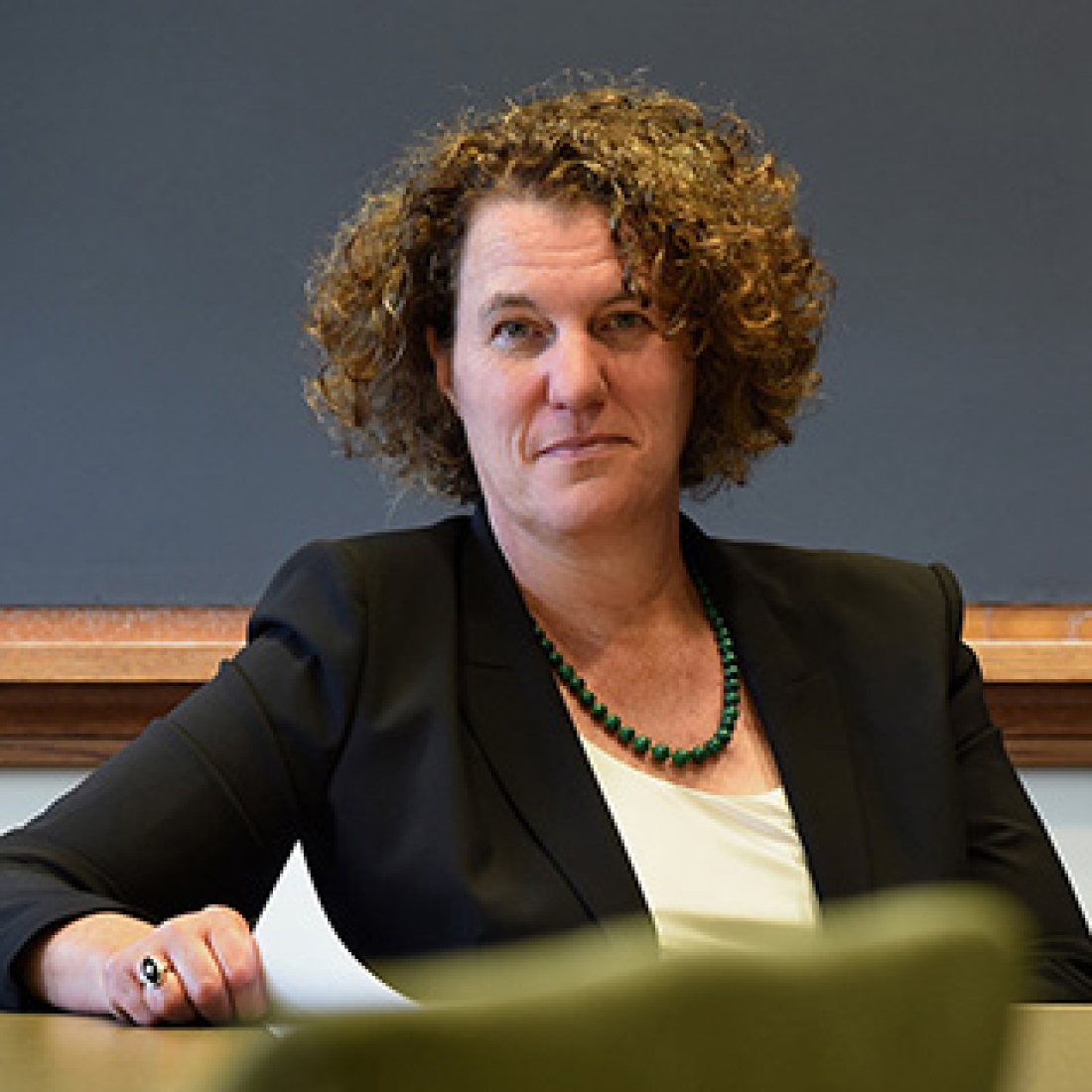
Hadas Eidelman

Jarvis R. Givens

Thomas Kane

James S. Kim

Irene Anastasia Liefshitz
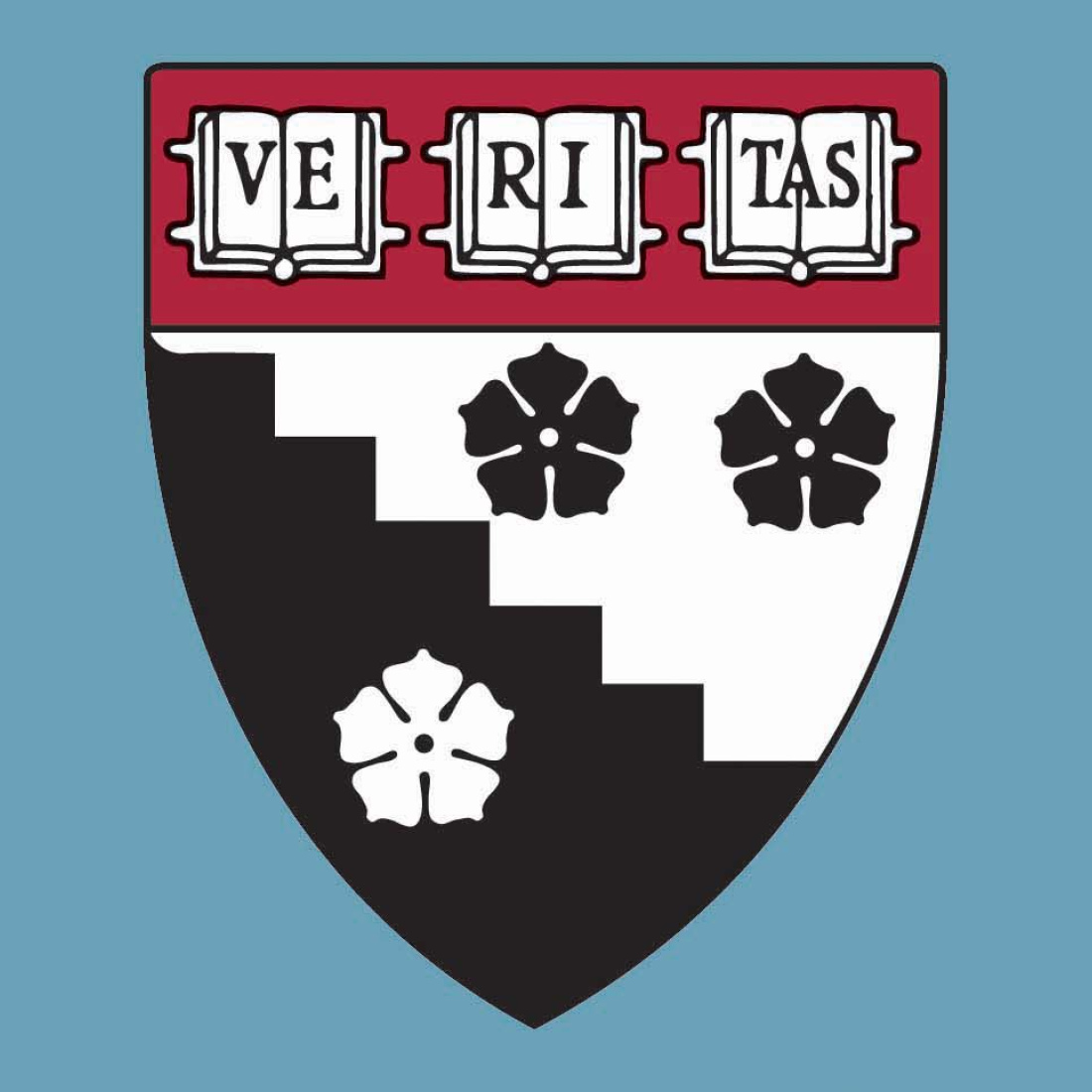
Joseph McIntyre

Luke W. Miratrix

Sebastian Munoz-Najar Galvez

Gabrielle Oliveira

Fernando Reimers

Paul Reville

Laura A. Schifter

Eric Taylor

Emiliana Vegas

Martin West

Career Pathways
The EPA Program prepares you for a variety of career pathways, including:
- Policy analyst
- Policy associate
- Local, state, or federal government professional
- Research associate or director of research
- Senior research portfolio manager
- Institutional research analyst
- Data analyst
- Program/project coordinator
- Program/project manager
- Community organizer
- Policy consultant
Cohort & Community
As an EPA student, you will be joining a community bound by a shared passion for improving education outcomes, opportunities, and systems through policy. The EPA cohort is comprised of learners from diverse professional backgrounds and levels of experience; from P–16 educators and leaders to policymakers and business executives; from the U.S. and diverse countries abroad; and from early childhood through postsecondary and adult education. Our community engages in shared learning inside and outside the classroom, including informal policy debates with faculty during brown bag lunches, panels with senior policy analysts who share advice on career pathways, and cohort-wide opportunities to learn about and from your peers.
Introduce Yourself
Tell us about yourself so that we can tailor our communication to best fit your interests and provide you with relevant information about our programs, events, and other opportunities to connect with us.
Program Highlights
Explore examples of the Education Policy and Analysis experience and the impact its community is making on the field:
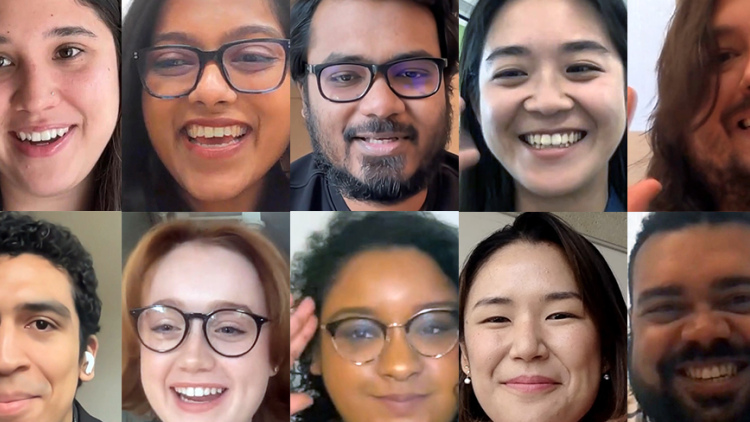
HGSE Honors Master's Students with Intellectual Contribution Award

HGSE Students Tackle Pandemic-Related Issues in Education
Understanding Educational Policies Essay
Human engagements have been characterized by rules and guidelines for a long period of time now. The processes involved in the setting out of these regulations take different forms and may vary from one country to another depending on how people are expected to interact and address the various challenges that may arise.
The guidelines are usually referred to as public policies since they are expected to provide general direction to the members of the public and to ensure social order (May, 2001). The process of formulating, formalization and implementation has proved to be a daunting task since each sector in the society has its own unique policies (Cockrel, 2004). Different stakeholders in the society that may be affected by the policies must be engaged in one way or another in the public policy formulation process.
The essay seeks to discuss and rate the influence of the legislative bodies, leadership, the justice system, as well as the bureaucracy on the formulation and implementation of educational policies. It will briefly discuss the general pattern in the public policy-making process. The influence of other entities, for instance interest groups, political parties, and the media will also be considered.
Public policy-making process is a product of interactions as well as dynamics among different actors, interest groups, public and private institutions and other technical processes preceding the enactment and interpretation of any public policy. Numerous definitions of policy and policy-making process have been used depending on the context.
For the purposes of this essay, a policy shall be defined as either an explicit or implicit decision or decisions made by a group that lays out the instructions for guiding the subsequent decisions, regulate actions, or monitoring prior decisions reached (Ben-Peretz, 2008). The process of making policies, therefore, varies in complexity as well as scope and the dynamics involved must be acknowledged. A number of models have been designed to provide a general format followed in the process of formulating a given public policy.
The stages involved are well sequenced from the primary level to the ultimate enactment, implementation and interpretation of the policies (Schmidt, Shelly & Crain, 2009). There are five major components in any of these models and they include; problem advocacy, the opponents, the concerned authorities, the implementation, and interpretation/evaluation of the given public policy (Cockrel, 2004).
The first step is the problem identification phase which involves the definition of the issue at hand that the policy will seek to address. This can be done by the concerned/line authorities, institutions, or activists. The advocates of a specified issue will raise people’s awareness and hence recruiting more of them into their course. The target number of people depends on the scope of the problem and the anticipated policy.
The next step involves the proposal of available alternatives for addressing the problems or conditions at hand. These proposals will provide a frame of action in alleviating the identified crisis. The third phase is the identification of appropriate authorities that will engineer the process of policy formulation. The concerned authorities will appoint/design a committee to investigate the problem and establish the magnitude.
It will also be expected to offer a refined list of recommendations for addressing the crisis. The authorities play a central role in determining the progress of the process because they can choose to take the proposals or decline to act. In order to keep the process moving, the advocates continue with the popularization process to gain a wider support from the members of the public. The public mood has been found to be a great determinant of the success in any major public reforms (Denhardt, 2008).
The process of advocacy usually encounters opposition of almost equal magnitude and hence defining another force. The model acknowledges the role of opposition since it plays a significant role in the entire process of policy formation and implementation (Cockrel, 2004). The opposition camp may emerge at any particular stage and the sequence parallels that of the policy advocates.
In most cases, the stages are similar since the opponents may emerge right at the first phase of problem identification, then proposals to counter those of the advocates are made and served to the appropriate authorities. After submitting their alternatives, the opponents will seek to expand their support base to rally against the advocates for policy formation.
The fifth phase is composed of three sections; decision by the authority, implementation, and evaluation. The concerned government authority and the policy makers engage in extensive deliberations with an aim of weighing the situation at hand (Cockrel, 2004). It is at this sub-stage that conflicts/oppositions and dilemmas emerge resulting in shifts in balance between major stakeholders like powerful people and activist groups in the society.
According to Ben-Peretz, these encounters may lead to either the implementation or decline of the proposed policy (2008). With successful negotiations and compromise among the concerned parties, the line authority issues a final decision on the policy. It is important to note that the sequences listed above provide just a general trend but it does not outline a strict step by step format to be followed (Denhardt, 2008).
Once the new policy is enacted it becomes publicly binding and the next stage is its implementation. It will be the responsibility of the authorities to monitor the implementation of the policy. There are two methods through which the policy can be implemented. The first is the revolutionary method where there is immediate transformation of an organization or institution following a top-down format (Ben-Peretz, 2008).
This approach is common in cases where the problem is identified by the authorities themselves. The other method is the evolutionary mode which normally results in a slow bottom-up transformation of the institution’s working pattern. The effectiveness of any policy is in its interpretations. Since all policies are developed to address specific problems, they ought to be evaluated for efficiency and relevance. This is done in the last stage of evaluating the implemented policy.
The evaluation process is usually done by the stakeholders; the advocates, opponents, or other interest groups. Formal methods of evaluation which include the collection of data and their analysis are usually employed. Alternatively, informal approaches like the subjective evaluation of citizens’ opinions about the new policy may be used (Schmidt et al., 2009). The findings from the evaluation stage will be used in gauging the general performance of the policy and the necessary changes effected accordingly.
As evidenced by the preceding discussion, the process of formulating and implementing any public policy involves several parties who may either be in agreement or holding different opinions about a given policy. In the formulation and implementation of an educational policy, a number of parties are usually at the center of the deliberations (Ben-Peretz, 2008).
Some of the stakeholders may include; the legislative bodies, the leadership, the justice system, and the bureaucracy (Dye, 2002). Other influential parties are the interest/activist groups, political parties, and the media.
It is clear that education takes many different forms for varying intentions and in many institutions. There is the early childhood education, first to twelfth grade studies, between two to four year college or university education, postgraduate and professional studies, pedagogical education as well as training for a specific job. This implies that education policies affect people across all ages and sectors related to education (Cockrel, 2004).
In the process of formulating educational policies for schools, issues such as the size of the school, student-teacher ratio, school control-either private or public, teacher training and certification, teaching approaches, nature of curricular and the content, qualifications for graduation, investment in infrastructural development, and the ethical values that schools are expected to observe(Dye, 2002).
The different parties have quite a significant difference when it comes to influencing the policy formulation and implementation process. The power of the legislative bodies like the members of government such as presidents or the Ministers of Education really play a central role in determining the fate of proposed educational policies (Ben-Peretz, 2008).
They are expected to ensure the formulation and enactment of good policies that will ensure both economic and social progress among the people. The legislature may be regarded as one of the most influential in the formulation of educational policies as well as their implementation and evaluation (Silver, 1990).
The legislative bodies are responsible for the enactment of rules and regulations that monitor educational practices at virtually all levels of government authorities. The legislature provides educational guidelines that are implemented in a top-down sequence since the policies are formulated by highly trained and skilled people. Normally, the legislative branches include the city councils, state legislature, or the Congress. In some situations, the legislative may be an executive agency or a court.
Understanding how the legislative bodies work in the formulation and implementation of educational policies is very important. The members are responsible for the identification of a given problem or condition that need to be addressed. A committee of experts is constituted and charged with the responsibility of investigating the problem and to make appropriate recommendations (Denhardt, 2008). The investigators collect different people’s opinions and analyze them before arriving at the recommendations.
Within a specified period of time, the committee avails its findings to the legislative bodies for consideration. It is at this stage that the legislature may opt to adopt the recommendations or decline to act on them. The final decision is then declared to the public for implementation. The new policies have clear steps for their implementation. The process of effecting the changes may be either long term (evolutionary mode) or within a short period of time which is also referred to as the revolutionary mode of implementation (Ben-Peretz, 2008).
In most cases, policies released to the public as legislative decrees or by executive orders are normally expected to be implemented with minimal resistance. Another influence of the legislature is in the fact that they are also the ones who receive the proposals from the advocates for change in the educational sector. However, given the numerous number of stakeholders in the education sector, some educational policies may be rejected and hence hampering with the implementation stage.
Moreover, legislative bodies are in direct control of government’s educational resources and may influence their distribution. Availing the resources may hasten the policy implementation process (Wilson, 2008). The legislative bodies at different levels of the society exert proportionate power on the formulation and implementation of educational policies.
The role of state legislature, for instance, is to review the policies in educational institutions and agencies and may issue orders for policy improvement. Any issues and problems arising from the educational sector are part of the agenda for the legislative bodies (Ben-Peretz, 2008). It is also evident that the legislatures respond to natural disasters, research findings, and other crises in education and trigger the formulation of appropriate policies.
The other source of influence of the legislative bodies is the fact that they are acknowledged as public decision-making organs (Wilson, 2008). They are therefore responsible for making the final decisions or policy choice with reference to the alternatives proposed by other stakeholders in the educational sector. They have to harmonize the often competing interests and opinions from the different actors in education.
Once they have formulated a given educational policy, the legislative bodies forward the new policy to the executive agencies which will facilitate their implementation (Wilson, 2008). When the legislators are forced to determine policies by voting, they would always be guided by the wishes of their constituents. The legislature holds a central role since they can assign duties, even to the executive by legislation.
Although the legislative bodies have been demonstrated to wield a lot of power in the policy formulation process, they do not have direct influence when it comes to the implementation of the new policies/laws (Schmidt et al., 2009). Other government agencies will be monitoring the implementation of the prescribed educational policies. The legislative bodies are therefore very effective in influencing educational policy formation, particularly during the formulation stage.
The second party that has influence on educational policy formulation and implementation process is the society’s leadership. The work of a leader is to have a vision of the future together with its associated challenges and to define and lead the way towards a brighter course.
In this respect, leaders of organizations, educational institutions, and political parties, among others must be in a position to identify issues and problems in the societal sectors (Wilson, 2008). They also propose alternative ways of addressing the problems and forwarding them to the legislative bodies for consideration.
The president as the leader of the states or a country has inherent discretionary powers to influence the policy formulation and implementation process. Most national leaders in the world have been known to influence the policies affecting education, and mostly through executive orders. They champion the legislation of appropriate policies that will bring meaningful transformation to the education sector (Silver, 1990).
Furthermore, governors, city managers, and mayors in most states and cities have overwhelming discretionary policy-making power. These leadership positions are elective and hence carry with it some public good will necessary to identify issues and problems as well as recommend solutions on their behalf (Wilson, 2008). This implies that the leaders will strive to ensure the enactment of universal access to basic education policy, subsidized higher education, guidelines for proper teacher training, as well as policies for adult education.
Leaders seeking elective positions usually have well written manifestos of how they will address societal problems, educational challenges included (Silver, 1990). Once they are elected, they are faced with the challenge of fulfilling the promises and hence they formulate policies for legislation purposes.
During the advocacy for a given transformation in the education sector, there is usually a leader who motivates people to agitate for the formation and implementation of policies. In order to give the necessary support to express the seriousness of their call, the leader recruits more people from the society so as to overcome any opposition forces that may emerge (Ben-Peretz, 2008).
Moreover, the leaders are usually in charge of committees and other decision-making groups and they will determine the general course of action in the policy formulation and implementation process. Depending on the nature of the new educational policy, leadership greatly influences the implementation process since they command respect from the people (Dye, 2002). In situations where unpopular policies are enacted, the same leaders will curtail the implementation process.
Hence leadership plays a central role when it comes to the general process of educational policy formation and implementation (Cockrel, 2004). It is therefore apparent to note that leadership has such a significant degree of influence on the process of formulating and implementing educational policies.
Further analysis of the forces that shape and influence the formulation and implementation of educational policies reveals that the justice system has great impact on the process. The role of the courts is usually to solve conflicts that may arise among different members of the society.
It is not easy to acknowledge the contribution of the courts towards policy formulation and implementation in most sectors (Dye, 2002). During the initial phase of advocacy, opposition may emerge and depending on the extent of impact of the anticipated policy, those opposed may opt to move to court to halt the advocacy.
With the judge as the decision-maker, he or she may give new directions that would shape the course of the agitation process hence contributing indirectly to the policy formulation process. This is reinforced by the fact that there will always be competing formulations of policies forcing the participants to want to seek the intervention of the courts (Wilson, 2008). The decisions made by the judiciary have been found to have far reaching consequences on the educational policy formulation and implementation.
The most significant influences of the courts are mainly felt when it comes to the implementation of a given educational policy. This is because there are more conflicts at the implementation phase compared to the formulation stage (Denhardt, 2008).
Some of the well-known examples include the civil rights cases which are sponsored by the court, particular in cases related to racial discrimination and abuse of labor force. In such a situation, the accused and the complainant act as the participants in the policy formulation and implementation while the judge is the final decision-maker (Wilson, 2008).
In most instances, the court may rule against one proposal and approve a new set of policies hence participating in the implementation process. The courts have the authority to analyze any educational policy that has any unconstitutional clauses. They can also promulgate new sets of policies with adherence to the principles outlined in the constitution. This demonstrates the influence of the judicial system in the formulation of public policies, particularly educational policies.
Instances that lead people to the court include conflicts involving two institutions, individuals against organizations, individuals against associations/groups, and among individuals. The complainant will be seeking assistance from the court on the proper interpretation of the educational policy at hand (May, 2001). This implies that the role of the courts in the formulation and implementation process cannot be ignored.
The fourth significant influential party in the formulation and implementation of educational policies is the governmental bureaucracies. They comprise of the civil/government employees who work in the different levels of the society and help in the formulation and implementation of government policies (Silver, 1990). Most of them occupy leadership positions and are able to influence the process of policy development.
Since they handle issues that may arise from the educational sector, they can easily identify problems in education that need to be addressed by the development of a policy (Dye, 2002). They are also well placed to receive backing from the people because they are recognized as part of the authority.
The bureaucracies are such a strong force in policy formulation and implementation because they consist of experts. They assist the government in making informed policies by designing appropriate policy proposals (Wilson, 2008). The formulation phase, therefore, will be quite easier since it may take a bottom-up trend and hence increasing the chances of a strong support and subsequent implementation of the policy.
In some states, the senior most government workers can issue orders that take the form of policies and ensure that they are observed. The state/federal government may also take recommendations from the members of the bureaucracy and use them to create new education policies (Wilson, 2008). Some transformations in the education sector like the need to review the system requires the advice of experts who can evaluate the significance of the policies before they are implemented.
The most significant role of the bureaucracies comes in handy when it comes to the implementation phase of the educational policy. When top government authorities pass new policies, they expect that they will be effectively implemented by their subordinates (Ben-Peretz, 2008). The task of implementation, however, may prove to be really challenging especially when it extends down to the lowest level of the society. Since most policies are developed by top government officials, they become easier to implement since they are usually passed on in a top-down approach.
The bureaucracies facilitate representation of the government at all levels of the society. They monitor the enforcement of the new policies depending on the preferred mode of implementation. Within the educational sector, the implementation of policies is greatly influenced by other agencies in the society apart from the main implementing agency (Ben-Peretz, 2008). The bureaucracy therefore will have to coordinate this sensitive stage. In most cases, they do not force the people to obey the policies, instead, they put into consideration personal concerns, difficulties, the members of the society, as well as other interests (Denhardt, 2008).
Most government bureaucracies, therefore, hold crucial information in the formulation and implementation of educational policies. The authority bestowed upon them helps in overcoming the influence of political forces especially those who may object the new policies (Wilson, 2008). In some states, most of the government agents are elected giving them an upper hand over the implementation of new government policies on education.
The bureaucracies control and regulate other policy makers in their territories like members of school boards as well as of city councils and local governments (Silver, 1990). They are responsible for the analysis of problems, formulation of policies, and monitoring their implementation and evaluation. These depict the degree of influence that the bureaucracies have over the formulation and implementation of educational policies.
The above four major parties at the center of the formulation and implementation of educational policies seem to wield uniquely significant influence on the process. Since each of them have the discretion to agree with the others or to hold differing opinions, there is need to always reach a consensus when it comes to issues affecting a wider section of the society (Dye, 2002). Most of the actors may remain adamant when it comes to sticking to their perspectives but the process of formulating policies will exhibit success especially when the policy provides for new ways of improving the education sector.
Challenges of implementation may however be difficult to avoid but the opposition may also end up improving the quality of the policy through reviews (Cockrel, 2004). In this context, therefore, it is not easy to rate chronologically the influence of the different entities on the formulation and implementation of the various educational policies. Their varying degrees of influence are situational and may compliment each other in ensuring the successful formulation and implementation of policies.
There are a number of other significant stakeholders in the education sector who play important roles in determining the success of the educational policies. Interest groups such as teachers unions and parents’ associations may be complimentary when it comes to both the formulation and implementation of a given education policy (Schmidt et al., 2009).
These groups may greatly help the primary implementing agency in achieving its goals as well as the objectives of the policy. Some of the nongovernmental agencies may be affected by the new policies. Their conventional ways of operations may need to be changed as a result of the new policies. With these requirements, the interest groups may support the implementation or totally resist the policies especially if their opinions were not sought during the policy formulation stage.
Moreover, the government provisions affecting such a sensitive field in the society as the school system will always receive extensive scrutiny from the members of the public. Any failure to take this consideration may result in difficulty when it comes to the implementation process.
Significant resistance from these quarters will force the review of the policies before they are eventually re-implemented. This implies that organized groups of people can exert pressure on the implementing agency to make the necessary alterations to the policies (May, 2001).
The other important actors in the formulation and implementation of public policies are the political parties. Political parties are always at cross-roads when it comes to advocacy for the different policies. As they seek election into government, different parties present their manifesto/agenda for the people. They accomplish this task by highlighting all the reforms that they intend to bring in the various sectors of the society (Schmidt et al., 2009).
They may also resort to criticizing the existing educational policies. The number of registered political parties is usually large. For instance, two major ones (Republican and Democratic) in the US normally exchange the national leadership roles. This periodic alternation of leadership has influenced the formulation and implementation of educational policies in most states.
The public media also plays a central role in the formulation and implementation of most public policies. The media can help in popularizing a given policy among the members of the society and hence gaining the approval necessary for its implementation (Ben-Peretz, 2008). In some cases, the proposed educational policy may be perceived to have far reaching negative impacts if implemented.
The media will therefore influence people’s opinions of the same resulting in implementation difficulty. Given the non-interactive nature of the media, people may easily end up developing negative attitudes towards a given policy on education. Therefore, the media just like the other stakeholders can have such a significant influence on the entire process of formulating and implementing the educational policies (May, 2001).
The essay has focused on the complex concept of parties involved in the formulation and implementation of educational policies and how each influences the process. The four major actors identified are; the legislative bodies, the leadership, the judiciary, and the government bureaucracy.
Other stakeholders discussed include the media, political parties, and the various interest groups. The essay has also highlighted a general model that can be used to illustrate stages through which public policy formation may take. However, the format is not fixed or meant to be followed in a step by step manner. Instead, it captures the basic processes involved and may take any order.
For instance, formation may come after the evaluation of a given policy for purposes of improving the provisions of the policy. It can be concluded that the various parties and actors in the formulation and implementation of educational policy can influence the process in their own special way. However, it may not be easy to categorize all of them in the order of degree of influence, particularly the first four parties.
Ben-Peretz, M. (2008). Policy-making in education: a holistic approach in response to global changes. Rowman & Littlefield Plc.
Cockrel, J. (2004). Public Policy-making in America . University of Kentucky Press
Denhardt, R. B. (2008). Theories of public organization (5 th ed.). Thomson Wadsworth
Dye, T. R. (2002). Understanding public policy . Upper Saddle River, Prentice Hall
May, P. (2001). “Reconsidering Policy Design: The Policies and Publics.” Journal of Public Policy Process , 4 (2), 186-209
Schmidt, S. W., Shelly, M. C. & Crain, E. (2009). American Government and Politics: a focus on public policy formation. Cengage Learning
Silver, H. (1990). Education, change, and the policy process. Taylor & Francis
Wilson, R. H. (2008). Public policy and community: activism and governance. University of Texas Press
- Chicago (A-D)
- Chicago (N-B)
IvyPanda. (2022, March 2). Understanding Educational Policies. https://ivypanda.com/essays/educational-policy/
"Understanding Educational Policies." IvyPanda , 2 Mar. 2022, ivypanda.com/essays/educational-policy/.
IvyPanda . (2022) 'Understanding Educational Policies'. 2 March.
IvyPanda . 2022. "Understanding Educational Policies." March 2, 2022. https://ivypanda.com/essays/educational-policy/.
1. IvyPanda . "Understanding Educational Policies." March 2, 2022. https://ivypanda.com/essays/educational-policy/.
Bibliography
IvyPanda . "Understanding Educational Policies." March 2, 2022. https://ivypanda.com/essays/educational-policy/.
- Positive functions of bureaucracies
- A Discussion on Bureaucracy & Post-Bureaucracies
- Bureaucracy and Post-bureaucracy
- Relevance of Bureaucracy to Modern Organizations
- Problems with Bureaucracy
- Why We Need a Bureaucracy
- Bureaucracy in the New York City Department of Education
- Bureaucracy and Accountability in Higher Education
- Bureaucracy as a Concept
- Bureaucracy in Weber's Theory and Modern World
- ‘Sociometric Stability and the Behavioral Correlates of Peer Acceptance in Early Childhood’
- The Neo-Vygotskian Approach to Child Development
- Professional Issues for Child and Youth Care Practitioners in School Based Settings
- Studying and Practicing - The Best Ways to Learn?
- Repairing Donated Children Books
- Skip to primary navigation
- Skip to main content
- Skip to primary sidebar
UPSC Coaching, Study Materials, and Mock Exams
Enroll in ClearIAS UPSC Coaching Join Now Log In
Call us: +91-9605741000
National Education Policy 2020: Key Highlights
Last updated on February 11, 2024 by Alex Andrews George
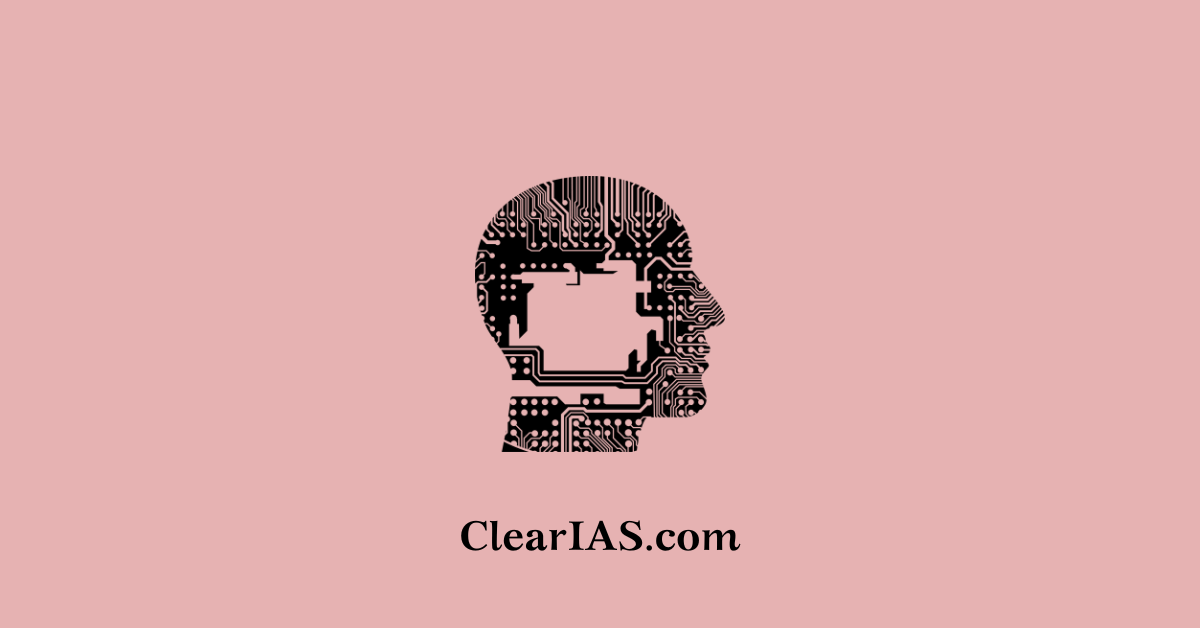
The National Education Policy 2020 aims to bring transformational reforms in school and higher education and thus shape India into a global knowledge superpower.
The Union Cabinet chaired by Prime Minister Shri Narendra Modi approved the National Education Policy 2020 on July 29, 2020. This policy replaced the 34-year-old National Policy on Education (NPE), in 1986.
Built on the foundational pillars of Access, Equity, Quality, Affordability, and Accountability, this policy is aligned with the 2030 Agenda for Sustainable Development.
The National Education Policy (NEP) aims to transform India into a vibrant knowledge society and global knowledge superpower by making both school and college education more holistic, flexible, and multidisciplinary, suited to 21st-century needs, and aimed at bringing out the unique capabilities of each student.
Table of Contents
Important Highlights of National Education Policy 2020
- New Policy aims for Universalization of Education from preschool to secondary level with 100 % GER in school education by 2030.
- NEP 2020 will bring 2 crore out-of-school children back into the mainstream.
- New 5+3+3+4 school curriculum with 12 years of schooling and 3 years of Anganwadi/ Pre-schooling.
- Emphasis on Foundational Literacy and Numeracy, no rigid separation between academic streams, extracurricular, and vocational streams in schools; Vocational Education to start from Class 6 with Internships.
- Teaching up to at least Grade 5 to be in mother tongue/ regional language.
- Assessment reforms with a 360-degree Holistic Progress Card, tracking Student Progress for achieving Learning Outcomes.
- GER in higher education to be raised to 50 % by 2035; 3.5 crore seats to be added in higher education.
- Higher Education curriculum to have Flexibility of Subjects.
- Multiple Entries / Exit to be allowed with appropriate certification.
- Academic Bank of Credits to be established to facilitate the Transfer of Credits.
- National Research Foundation to be established to foster a strong research culture.
- Light but Tight Regulation of Higher Education, single regulator with four separate verticals for different functions.
- Affiliation System to be phased out in 15 years with graded autonomy to colleges.
- NEP 2020 advocates increased use of technology with equity; National Educational Technology Forum to be created.
- NEP 2020 emphasizes setting up of Gender Inclusion Fund and Special Education Zones for disadvantaged regions and groups.
- New Policy promotes Multilingualism in both schools and HEs; the National Institute for Pali, Persian, and Prakrit, Indian Institute of Translation and Interpretation to be set up.
National Education Policy 2020: School Education
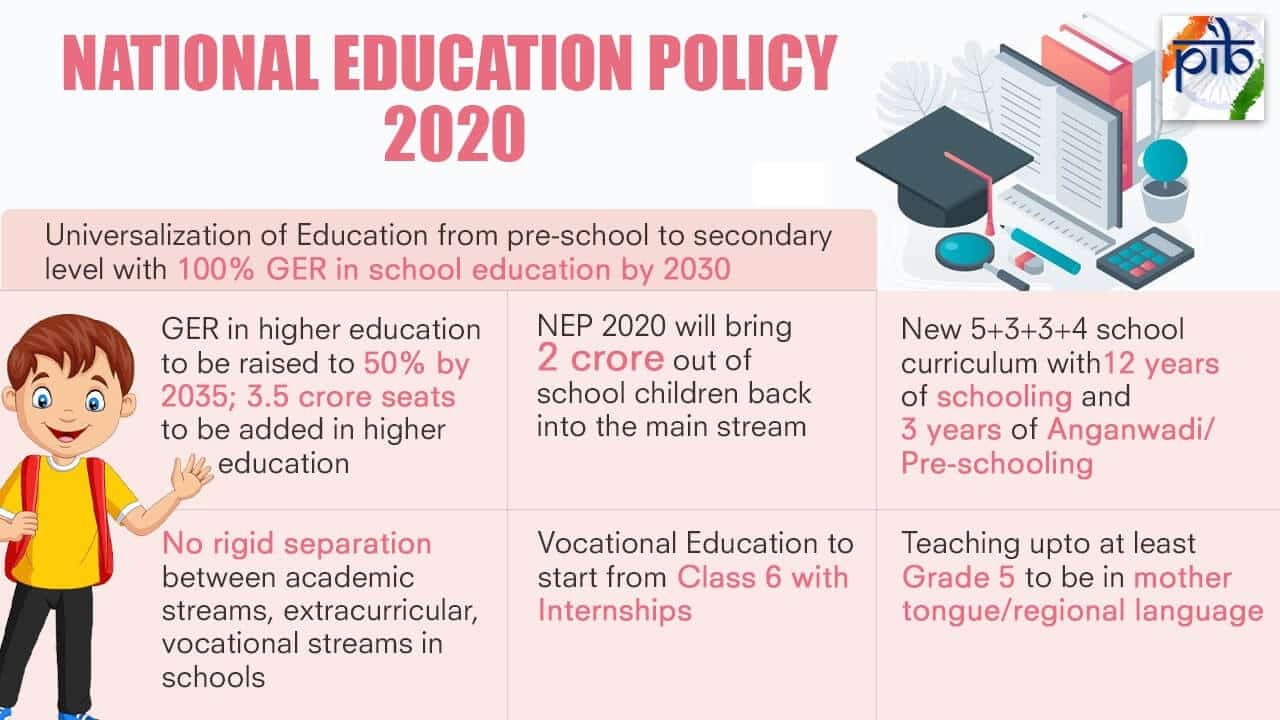
With respect to school education, universal access is the key vision. Also, major reforms are brought in curriculum and pedagogy.

Ensuring Universal Access at all levels of school education
NEP 2020 emphasizes on ensuring universal access to school education at all levels- preschool to secondary.
Infrastructure support, innovative education centers to bring back dropouts into the mainstream, tracking of students and their learning levels, facilitating multiple pathways to learning involving both formal and non-formal education modes, an association of counselors or well-trained social workers with schools, open learning for classes 3,5 and 8 through NIOS and State Open Schools, secondary education programs equivalent to Grades 10 and 12, vocational courses, adult literacy, and life-enrichment programs are some of the proposed ways for achieving this.
About 2 crore out-of-school children will be brought back into the mainstream under NEP 2020.
Also read: Examination System in India
Early Childhood Care & Education with New Curricular and Pedagogical Structure
With an emphasis on Early Childhood Care and Education, the 10+2 structure of school curricula is to be replaced by a 5+3+3+4 curricular structure corresponding to ages 3-8, 8-11, 11-14, and 14-18 years respectively. This will bring the hitherto uncovered age group of 3-6 years under the school curriculum, which has been recognized globally as the crucial stage for the development of the mental faculties of a child. The new system will have 12 years of schooling with three years of Anganwadi/ pre-schooling.
Join Now: CSAT Course
NCERT will develop a National Curricular and Pedagogical Framework for Early Childhood Care and Education (NCPFECCE) for children up to the age of 8. ECCE will be delivered through a significantly expanded and strengthened system of institutions including Anganwadis and pre-schools that will have teachers and Anganwadi workers trained in the ECCE pedagogy and curriculum. The planning and implementation of ECCE will be carried out jointly by the Ministries of HRD, Women and Child Development (WCD), Health and Family Welfare (HFW), and Tribal Affairs.
Attaining Foundational Literacy and Numeracy
Recognizing Foundational Literacy and Numeracy as an urgent and necessary prerequisite to learning, NEP 2020 calls for the setting up of a National Mission on Foundational Literacy and Numeracy by MHRD.
States will prepare an implementation plan for attaining universal foundational literacy and numeracy in all primary schools for all learners by grade 3 by 2025. A National Book Promotion Policy is to be formulated.
Reforms in school curricula and pedagogy
The school curricula and pedagogy will aim for the holistic development of learners by equipping them with key 21st-century skills, reduction in curricular content to enhance essential learning and critical thinking, and a greater focus on experiential learning.
Students will have increased flexibility and choice of subjects. There will be no rigid separations between arts and sciences, between curricular and extra-curricular activities, and between vocational and academic streams.

Vocational education will start in schools from the 6th grade and will include internships.
A new and comprehensive National Curricular Framework for School Education, NCFSE 2020-21, will be developed by the NCERT.
Multilingualism and the power of language
The policy has emphasized mother tongue /local language/regional language as the medium of instruction at least till Grade 5, but preferably till Grade 8 and beyond. Sanskrit to be offered at all levels of school and higher education as an option for students, including in the three-language formula. Other classical languages and literature of India also to be available as options. No language will be imposed on any student.
Students to participate in a fun project/activity on ‘The Languages of India’, sometime in Grades 6-8, such as, under the ‘Ek Bharat Shrestha Bharat’ initiative. Several foreign languages will also be offered at the secondary level. Indian Sign Language (ISL) will be standardized across the country, and National and State curriculum materials developed, for use by students with hearing impairment.
Assessment Reforms
NEP 2020 envisages a shift from summative assessment to regular and formative assessment, which is more competency-based, promotes learning and development, and tests higher-order skills, such as analysis, critical thinking, and conceptual clarity. All students will take school examinations in Grades 3, 5, and 8 which will be conducted by the appropriate authority.
Board exams for Grades 10 and 12 will be continued, but redesigned with holistic development as the aim. A new National Assessment Centre, PARAKH (Performance Assessment, Review, and Analysis of Knowledge for Holistic Development), will be set up as a standard-setting body.
Equitable and Inclusive Education
NEP 2020 aims to ensure that no child loses any opportunity to learn and excel because of the circumstances of birth or background. Special emphasis will be given to Socially and Economically Disadvantaged Groups (SDGs), including gender, sociocultural, and geographical identities and disabilities. This includes setting up of Gender Inclusion Fund and also Special Education Zones for disadvantaged regions and groups.
Children with disabilities will be enabled to fully participate in the regular schooling process from the foundational stage to higher education, with the support of educators with cross-disability training, resource centers, accommodations, assistive devices, appropriate technology-based tools, and other support mechanisms tailored to suit their needs.
Every state/district will be encouraged to establish “Bal Bhavans” as a special daytime boarding school, to participate in art-related, career-related, and play-related activities. Free school infrastructure can be used as Samajik Chetna Kendras
Also read: Education in India – A Detailed Analysis
Robust Teacher Recruitment and Career Path
Teachers will be recruited through robust, transparent processes. Promotions will be merit-based, with a mechanism for multi-source periodic performance appraisals and available progression paths to becoming educational administrators or teacher educators. A common National Professional Standard for Teachers (NPST) will be developed by the National Council for Teacher Education by 2022, in consultation with NCERT , SCERTs, teachers, and expert organizations from across levels and regions.
School Governance
Schools can be organized into complexes or clusters which will be the basic unit of governance and ensure the availability of all resources including infrastructure, academic libraries, and a strong professional teacher community.
Standard-setting and Accreditation for School Education
NEP 2020 envisages clear, separate systems for policymaking, regulation, operations, and academic matters. States/UTs will set up an independent State School Standards Authority (SSSA). Transparent public self-disclosure of all the basic regulatory information, as laid down by the SSSA, will be used extensively for public oversight and accountability. The SCERT will develop a School Quality Assessment and Accreditation Framework (SQAAF) through consultations with all stakeholders.
National Education Policy: Higher Education
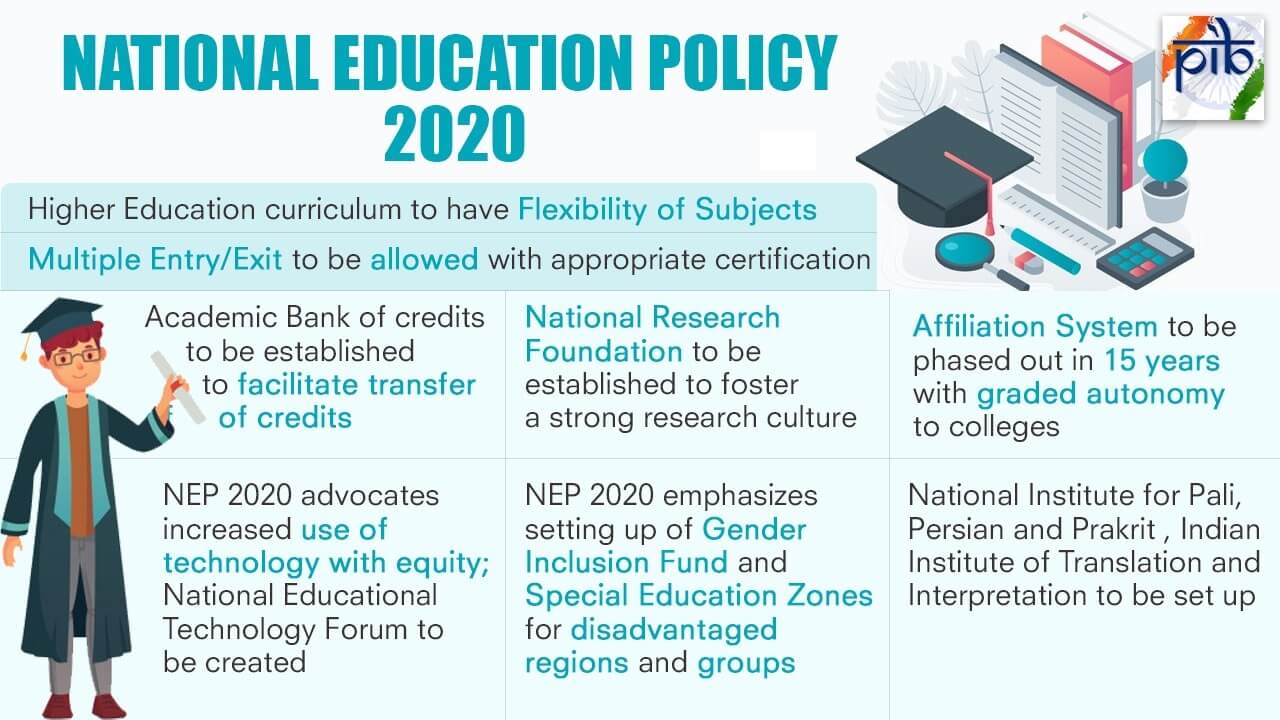
The New Education Policy has a great vision for the Higher Education sector as well.
Increase GER to 50 % by 2035
NEP 2020 aims to increase the Gross Enrolment Ratio in higher education including vocational education from 26.3% (2018) to 50% by 2035. 3.5 Crore new seats will be added to Higher education institutions.
Holistic Multidisciplinary Education
The policy envisages broad-based, multi-disciplinary, holistic Undergraduate education with flexible curricula, creative combinations of subjects, integration of vocational education, and multiple entries and exit points with appropriate certification. UG education can be of 3 or 4 years with multiple exit options and appropriate certification within this period. For example, a Certificate after 1 year, Advanced Diploma after 2 years, a Bachelor’s Degree after 3 years, and a Bachelor’s with Research after 4 years.
An Academic Bank of Credit is to be established for digitally storing academic credits earned from different HEIs so that these can be transferred and counted towards the final degree made.
Multidisciplinary Education and Research Universities (MERUs), at par with IITs, and IIMs, to be set up as models of the best multidisciplinary education of global standards in the country.
The National Research Foundation will be created as an apex body for fostering a strong research culture and building research capacity across higher education.
The Higher Education Commission of India(HECI) will be set up as a single overarching umbrella body for the entire higher education, excluding medical and legal education . HECI to have four independent verticals – the National Higher Education Regulatory Council (NHERC) for regulation, the General Education Council (GEC ) for standard-setting, the Higher Education Grants Council (HEGC) for funding, and the National Accreditation Council( NAC) for accreditation.
HECI will function through faceless intervention through technology, & will have powers to penalize HEIs not conforming to norms and standards. Public and private higher education institutions will be governed by the same set of norms for regulation, accreditation, and academic standards.
Rationalized Institutional Architecture
Higher education institutions will be transformed into large, well-resourced, vibrant multidisciplinary institutions providing high-quality teaching, research, and community engagement. The definition of the university will allow a spectrum of institutions that range from research-intensive Universities to Teaching-intensive Universities and Autonomous degree-granting Colleges.
Affiliation of colleges is to be phased out in 15 years and a stage-wise mechanism is to be established for granting graded autonomy to colleges. Over a period of time, it is envisaged that every college would develop into either an Autonomous degree-granting College or a constituent college of a university.
Motivated, Energized, and Capable Faculty
NEP makes recommendations for motivating, energizing, and building the capacity of faculty through clearly defined, independent, transparent recruitment, freedom to design curricula/pedagogy, incentivizing excellence, and movement into institutional leadership. Faculty not delivering on basic norms will be held accountable
Teacher Education
A new and comprehensive National Curriculum Framework for Teacher Education, NCFTE 2021, will be formulated by the NCTE in consultation with NCERT. By 2030, the minimum degree qualification for teaching will be a 4-year integrated B.Ed. degree. Stringent action will be taken against substandard stand-alone Teacher Education Institutions (TEIs).
Mentoring Mission
A National Mission for Mentoring will be established, with a large pool of outstanding senior/retired faculty – including those with the ability to teach in Indian languages – who would be willing to provide short and long-term mentoring/professional support to university/college teachers.
Financial support for students
Efforts will be made to incentivize the merit of students belonging to SC, ST, OBC, and other SEDGs. The National Scholarship Portal will be expanded to support, foster, and track the progress of students receiving scholarships. Private HEIs will be encouraged to offer larger numbers of free ships and scholarships to their students.
Open and Distance Learning
This will be expanded to play a significant role in increasing GER. Measures such as online courses and digital repositories, funding for research, improved student services, credit-based recognition of MOOCs, etc., will be taken to ensure it is at par with the highest quality in-class programs.
Online Education and Digital Education:
A comprehensive set of recommendations for promoting online education consequent to the recent rise in epidemics and pandemics in order to ensure preparedness with alternative modes of quality education whenever and wherever traditional and in-person modes of education are not possible has been covered.
A dedicated unit for the purpose of orchestrating the building of digital infrastructure, digital content, and capacity building will be created in the MHRD to look after the e-education needs of both school and higher education.
Technology in education
An autonomous body, the National Educational Technology Forum (NETF), will be created to provide a platform for the free exchange of ideas on the use of technology to enhance learning, assessment, planning, and administration. Appropriate integration of technology into all levels of education will be done to improve classroom processes, support teacher professional development, enhance educational access for disadvantaged groups, and streamline educational planning, administration, and management
Promotion of Indian languages
To ensure the preservation, growth, and vibrancy of all Indian languages, NEP recommends setting up an Indian Institute of Translation and Interpretation (IITI), National Institute (or Institutes) for Pali, Persian, and Prakrit, strengthening Sanskrit and all language departments in HEIs, and use mother tongue/local language as a medium of instruction in more HEI programs.
Internationalization of education will be facilitated through both institutional collaborations and student and faculty mobility allowing entry of top world-ranked Universities to open campuses in our country.
Professional Education
All professional education will be an integral part of the higher education system. Stand-alone technical universities, health science universities, legal and agricultural universities, etc. will aim to become multi-disciplinary institutions.
Adult Education
The policy aims to achieve 100% youth and adult literacy.
Financing Education
The Centre and the States will work together to increase public investment in the Education sector to reach 6% of GDP at the earliest.
Also read: PM-USHA
NEP: Consultation Process
NEP 2020 has been formulated after an unprecedented process of consultation that involved nearly over 2 lakh suggestions from 2.5 lakh Gram Panchayats, 6600 Blocks, 6000 ULBs, and 676 Districts.
The MHRD initiated an unprecedented collaborative, inclusive, and highly participatory consultation process in January 2015. In May 2016, ‘The Committee for Evolution of the New Education Policy’ under the Chairmanship of Late Shri T.S.R. Subramanian, Former Cabinet Secretary, submitted its report.
Based on this, the Ministry prepared ‘Some Inputs for the Draft National Education Policy, 2016’. In June 2017 a ‘Committee for the Draft National Education Policy’ was constituted under the Chairmanship of eminent Scientist Padma Vibhushan, Dr. K. Kasturirangan, which submitted the Draft National Education Policy, 2019 to the Hon’ble Human Resource Development Minister on 31st May 2019.
The Draft National Education Policy 2019 was uploaded on MHRD’s website and at the ‘MyGov Innovate’ portal eliciting views/suggestions/comments from stakeholders, including the public.
In conclusion, the National Education Policy (NEP) is a crucial document that outlines the roadmap for the development of education in India. It is a significant step towards building a knowledge-based society that is equipped to meet the challenges of the 21st century. The NEP aims to transform the education system by providing equitable access to quality education, promoting innovation, and fostering holistic development.
The policy emphasizes the need for a learner-centered approach that focuses on critical thinking, creativity, and problem-solving. It also seeks to promote interdisciplinary learning, multilingualism, and the integration of vocational education into the mainstream curriculum.
The NEP’s vision of a flexible and inclusive education system that enables lifelong learning is laudable. However, the success of the policy will depend on its effective implementation, which will require adequate funding, infrastructure, and skilled educators.
Overall, the NEP has the potential to revolutionize the education sector in India and make it more relevant and responsive to the needs of the changing world. It is a bold and visionary document that seeks to transform education from being a means of social mobility to a tool for building a better and more just society.
Also Read: Institutions of Eminence Scheme

Take a Test: Analyse Your Progress
Aim IAS, IPS, or IFS?
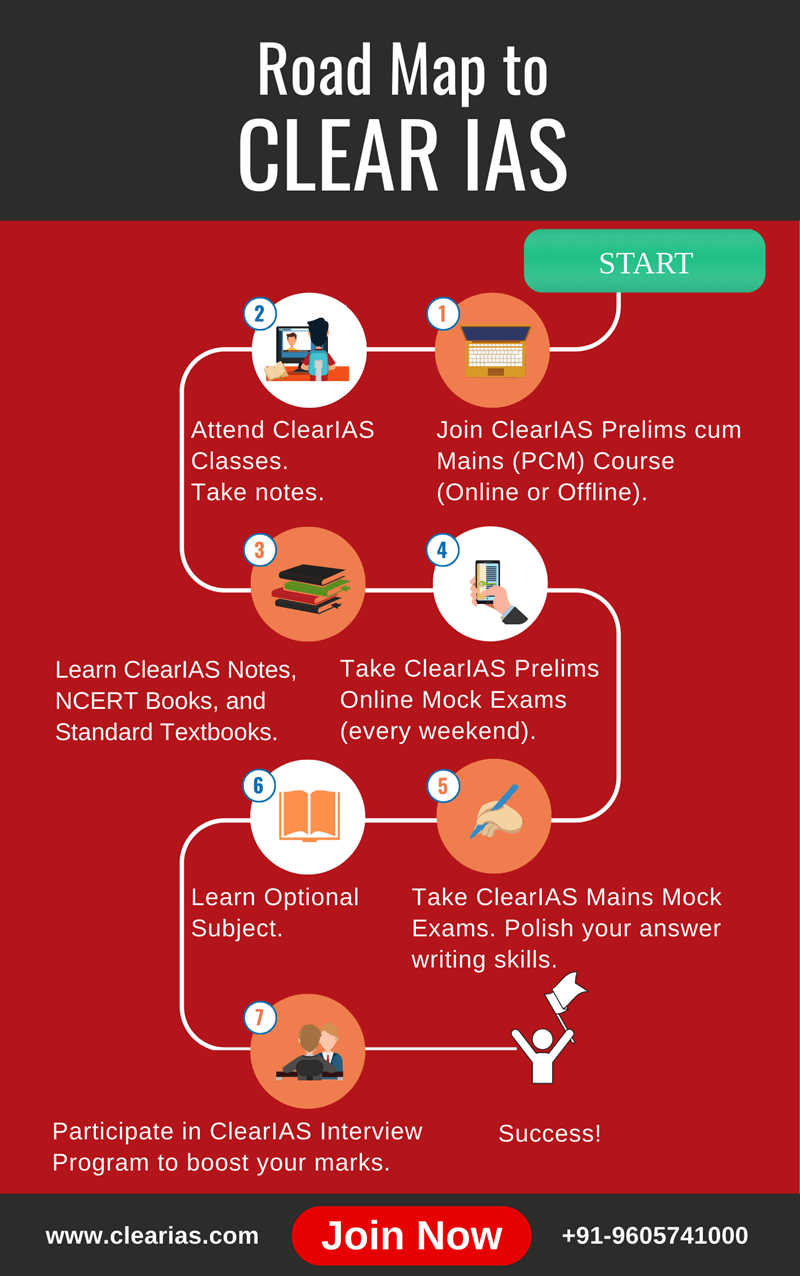
About Alex Andrews George
Alex Andrews George is a mentor, author, and social entrepreneur. Alex is the founder of ClearIAS and one of the expert Civil Service Exam Trainers in India.
He is the author of many best-seller books like 'Important Judgments that transformed India' and 'Important Acts that transformed India'.
A trusted mentor and pioneer in online training , Alex's guidance, strategies, study-materials, and mock-exams have helped many aspirants to become IAS, IPS, and IFS officers.
Reader Interactions
July 30, 2020 at 4:52 pm
Sir My doubt is I am a MPhil holder in this year.Is there is no value of my certificate in future.
Regards Revathy.R
August 7, 2020 at 8:28 am
Dear Madam, No, It will help you to complete your Ph.D in short duration. At present you may submit your Ph.D in 4 years. Regards, Jeeva
July 30, 2020 at 4:54 pm
@Revathy: Why do you think so?
June 5, 2021 at 10:55 am
Sir, Is the BA is good graduation for upsc or not ?
Leave a Reply Cancel reply
Your email address will not be published. Required fields are marked *
Don’t lose out without playing the right game!
Follow the ClearIAS Prelims cum Mains (PCM) Integrated Approach.
Join ClearIAS PCM Course Now
UPSC Online Preparation
- Union Public Service Commission (UPSC)
- Indian Administrative Service (IAS)
- Indian Police Service (IPS)
- IAS Exam Eligibility
- UPSC Free Study Materials
- UPSC Exam Guidance
- UPSC Prelims Test Series
- UPSC Syllabus
- UPSC Online
- UPSC Prelims
- UPSC Interview
- UPSC Toppers
- UPSC Previous Year Qns
- UPSC Age Calculator
- UPSC Calendar 2024
- About ClearIAS
- ClearIAS Programs
- ClearIAS Fee Structure
- IAS Coaching
- UPSC Coaching
- UPSC Online Coaching
- ClearIAS Blog
- Important Updates
- Announcements
- Book Review
- ClearIAS App
- Work with us
- Advertise with us
- Privacy Policy
- Terms and Conditions
- Talk to Your Mentor
Featured on

and many more...
- CBSE Class 10th
- CBSE Class 12th
- UP Board 10th
- UP Board 12th
- Bihar Board 10th
- Bihar Board 12th
- Top Schools in India
- Top Schools in Delhi
- Top Schools in Mumbai
- Top Schools in Chennai
- Top Schools in Hyderabad
- Top Schools in Kolkata
- Top Schools in Pune
- Top Schools in Bangalore
Products & Resources
- JEE Main Knockout April
- Free Sample Papers
- Free Ebooks
- NCERT Notes
- NCERT Syllabus
- NCERT Books
- RD Sharma Solutions
- Navodaya Vidyalaya Admission 2024-25
- NCERT Solutions
- NCERT Solutions for Class 12
- NCERT Solutions for Class 11
- NCERT solutions for Class 10
- NCERT solutions for Class 9
- NCERT solutions for Class 8
- NCERT Solutions for Class 7
- JEE Main 2024
- MHT CET 2024
- JEE Advanced 2024
- BITSAT 2024
- View All Engineering Exams
- Colleges Accepting B.Tech Applications
- Top Engineering Colleges in India
- Engineering Colleges in India
- Engineering Colleges in Tamil Nadu
- Engineering Colleges Accepting JEE Main
- Top IITs in India
- Top NITs in India
- Top IIITs in India
- JEE Main College Predictor
- JEE Main Rank Predictor
- MHT CET College Predictor
- AP EAMCET College Predictor
- GATE College Predictor
- KCET College Predictor
- JEE Advanced College Predictor
- View All College Predictors
- JEE Main Question Paper
- JEE Main Cutoff
- JEE Main Answer Key
- JEE Main Result
- Download E-Books and Sample Papers
- Compare Colleges
- B.Tech College Applications
- JEE Advanced Registration
- MAH MBA CET Exam
- View All Management Exams
Colleges & Courses
- MBA College Admissions
- MBA Colleges in India
- Top IIMs Colleges in India
- Top Online MBA Colleges in India
- MBA Colleges Accepting XAT Score
- BBA Colleges in India
- XAT College Predictor 2024
- SNAP College Predictor
- NMAT College Predictor
- MAT College Predictor 2024
- CMAT College Predictor 2024
- CAT Percentile Predictor 2023
- CAT 2023 College Predictor
- CMAT 2024 Registration
- TS ICET 2024 Registration
- CMAT Exam Date 2024
- MAH MBA CET Cutoff 2024
- Download Helpful Ebooks
- List of Popular Branches
- QnA - Get answers to your doubts
- IIM Fees Structure
- AIIMS Nursing
- Top Medical Colleges in India
- Top Medical Colleges in India accepting NEET Score
- Medical Colleges accepting NEET
- List of Medical Colleges in India
- List of AIIMS Colleges In India
- Medical Colleges in Maharashtra
- Medical Colleges in India Accepting NEET PG
- NEET College Predictor
- NEET PG College Predictor
- NEET MDS College Predictor
- DNB CET College Predictor
- DNB PDCET College Predictor
- NEET Application Form 2024
- NEET PG Application Form 2024
- NEET Cut off
- NEET Online Preparation
- Download Helpful E-books
- LSAT India 2024
- Colleges Accepting Admissions
- Top Law Colleges in India
- Law College Accepting CLAT Score
- List of Law Colleges in India
- Top Law Colleges in Delhi
- Top Law Collages in Indore
- Top Law Colleges in Chandigarh
- Top Law Collages in Lucknow
Predictors & E-Books
- CLAT College Predictor
- MHCET Law ( 5 Year L.L.B) College Predictor
- AILET College Predictor
- Sample Papers
- Compare Law Collages
- Careers360 Youtube Channel
- CLAT Syllabus 2025
- CLAT Previous Year Question Paper
- AIBE 18 Result 2023
- NID DAT Exam
- Pearl Academy Exam
Animation Courses
- Animation Courses in India
- Animation Courses in Bangalore
- Animation Courses in Mumbai
- Animation Courses in Pune
- Animation Courses in Chennai
- Animation Courses in Hyderabad
- Design Colleges in India
- Fashion Design Colleges in Bangalore
- Fashion Design Colleges in Mumbai
- Fashion Design Colleges in Pune
- Fashion Design Colleges in Delhi
- Fashion Design Colleges in Hyderabad
- Fashion Design Colleges in India
- Top Design Colleges in India
- Free Design E-books
- List of Branches
- Careers360 Youtube channel
- NIFT College Predictor
- UCEED College Predictor
- NID DAT College Predictor
- IPU CET BJMC
- JMI Mass Communication Entrance Exam
- IIMC Entrance Exam
- Media & Journalism colleges in Delhi
- Media & Journalism colleges in Bangalore
- Media & Journalism colleges in Mumbai
- List of Media & Journalism Colleges in India
- CA Intermediate
- CA Foundation
- CS Executive
- CS Professional
- Difference between CA and CS
- Difference between CA and CMA
- CA Full form
- CMA Full form
- CS Full form
- CA Salary In India
Top Courses & Careers
- Bachelor of Commerce (B.Com)
- Master of Commerce (M.Com)
- Company Secretary
- Cost Accountant
- Charted Accountant
- Credit Manager
- Financial Advisor
- Top Commerce Colleges in India
- Top Government Commerce Colleges in India
- Top Private Commerce Colleges in India
- Top M.Com Colleges in Mumbai
- Top B.Com Colleges in India
- IT Colleges in Tamil Nadu
- IT Colleges in Uttar Pradesh
- MCA Colleges in India
- BCA Colleges in India
Quick Links
- Information Technology Courses
- Programming Courses
- Web Development Courses
- Data Analytics Courses
- Big Data Analytics Courses
- RUHS Pharmacy Admission Test
- Top Pharmacy Colleges in India
- Pharmacy Colleges in Pune
- Pharmacy Colleges in Mumbai
- Colleges Accepting GPAT Score
- Pharmacy Colleges in Lucknow
- List of Pharmacy Colleges in Nagpur
- GPAT Result
- GPAT 2024 Admit Card
- GPAT Question Papers
- NCHMCT JEE 2024
- Mah BHMCT CET
- Top Hotel Management Colleges in Delhi
- Top Hotel Management Colleges in Hyderabad
- Top Hotel Management Colleges in Mumbai
- Top Hotel Management Colleges in Tamil Nadu
- Top Hotel Management Colleges in Maharashtra
- B.Sc Hotel Management
- Hotel Management
- Diploma in Hotel Management and Catering Technology
Diploma Colleges
- Top Diploma Colleges in Maharashtra
- UPSC IAS 2024
- SSC CGL 2024
- IBPS RRB 2024
- Previous Year Sample Papers
- Free Competition E-books
- Sarkari Result
- QnA- Get your doubts answered
- UPSC Previous Year Sample Papers
- CTET Previous Year Sample Papers
- SBI Clerk Previous Year Sample Papers
- NDA Previous Year Sample Papers
Upcoming Events
- NDA Application Form 2024
- UPSC IAS Application Form 2024
- CDS Application Form 2024
- CTET Admit card 2024
- HP TET Result 2023
- SSC GD Constable Admit Card 2024
- UPTET Notification 2024
- SBI Clerk Result 2024
Other Exams
- SSC CHSL 2024
- UP PCS 2024
- UGC NET 2024
- RRB NTPC 2024
- IBPS PO 2024
- IBPS Clerk 2024
- IBPS SO 2024
- Top University in USA
- Top University in Canada
- Top University in Ireland
- Top Universities in UK
- Top Universities in Australia
- Best MBA Colleges in Abroad
- Business Management Studies Colleges
Top Countries
- Study in USA
- Study in UK
- Study in Canada
- Study in Australia
- Study in Ireland
- Study in Germany
- Study in China
- Study in Europe
Student Visas
- Student Visa Canada
- Student Visa UK
- Student Visa USA
- Student Visa Australia
- Student Visa Germany
- Student Visa New Zealand
- Student Visa Ireland
- CUET PG 2024
- IGNOU B.Ed Admission 2024
- DU Admission 2024
- UP B.Ed JEE 2024
- DDU Entrance Exam
- IIT JAM 2024
- IGNOU Online Admission 2024
- Universities in India
- Top Universities in India 2024
- Top Colleges in India
- Top Universities in Uttar Pradesh 2024
- Top Universities in Bihar
- Top Universities in Madhya Pradesh 2024
- Top Universities in Tamil Nadu 2024
- Central Universities in India
- CUET Exam City Intimation Slip 2024
- IGNOU Date Sheet
- CUET Mock Test 2024
- CUET Admit card 2024
- CUET PG Syllabus 2024
- CUET Participating Universities 2024
- CUET Previous Year Question Paper
- CUET Syllabus 2024 for Science Students
- E-Books and Sample Papers
- CUET Exam Pattern 2024
- CUET Exam Date 2024
- CUET Syllabus 2024
- IGNOU Exam Form 2024
- IGNOU Result
- CUET Courses List 2024
Engineering Preparation
- Knockout JEE Main 2024
- Test Series JEE Main 2024
- JEE Main 2024 Rank Booster
Medical Preparation
- Knockout NEET 2024
- Test Series NEET 2024
- Rank Booster NEET 2024
Online Courses
- JEE Main One Month Course
- NEET One Month Course
- IBSAT Free Mock Tests
- IIT JEE Foundation Course
- Knockout BITSAT 2024
- Career Guidance Tool
Top Streams
- IT & Software Certification Courses
- Engineering and Architecture Certification Courses
- Programming And Development Certification Courses
- Business and Management Certification Courses
- Marketing Certification Courses
- Health and Fitness Certification Courses
- Design Certification Courses
Specializations
- Digital Marketing Certification Courses
- Cyber Security Certification Courses
- Artificial Intelligence Certification Courses
- Business Analytics Certification Courses
- Data Science Certification Courses
- Cloud Computing Certification Courses
- Machine Learning Certification Courses
- View All Certification Courses
- UG Degree Courses
- PG Degree Courses
- Short Term Courses
- Free Courses
- Online Degrees and Diplomas
- Compare Courses

Top Providers
- Coursera Courses
- Udemy Courses
- Edx Courses
- Swayam Courses
- upGrad Courses
- Simplilearn Courses
- Great Learning Courses
Access premium articles, webinars, resources to make the best decisions for career, course, exams, scholarships, study abroad and much more with
Plan, Prepare & Make the Best Career Choices
- Essay on New Education Policy (NEP)
Education helps us discover and accomplish our aims and make a fair contribution to the society. In a similar vein, education contributes significantly to a country's national growth. The National Education Policy 2020 was authorised by the Government of India since there is a significant change taking place in the world. Here are some sample essays on New Education Policy 2023.
100 Words Essay on New Education Policy
200 words essay on new education policy, 500 words essay on new education policy 2023.
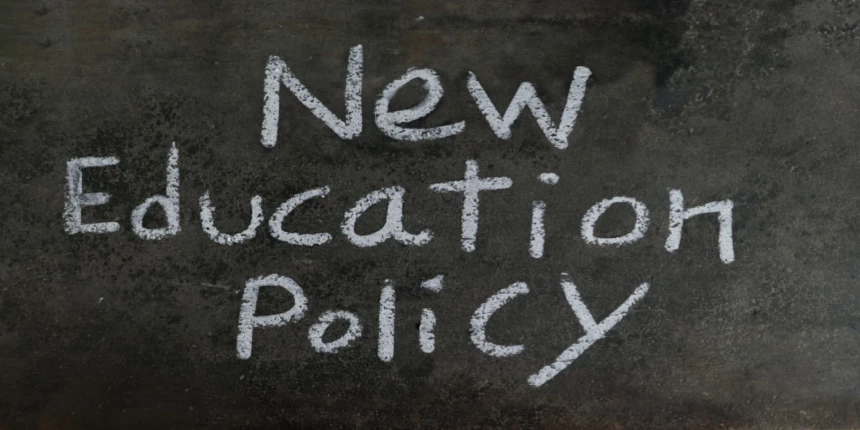
The goal of the New Education Policy is to make education available to everyone from preschool through high school. With a 100% GRE (Gross Enrollment Ratio) in academics, it intends to achieve that. It is intended to be accomplished by 2030. A four-year, interdisciplinary undergraduate curriculum with a range of exit choices is what it intends to introduce. As a result, this new strategy aims to transform India into a superpower in the field of knowledge.
In similar terms, it seeks to make all colleges and universities multidisciplinary by the year 2040. The initiative also intends to fundamentally alter the current educational system while increasing the availability of jobs in India.
The New National Education Policy has had a really revolutionary impact on the Indian educational system. After 34 years of our education policy following the same standards without change, the Ministry of Education (formerly known as MHRD) made some significant changes to it on July 29, 2020. The Indian government just adopted this New National Education Policy for 2023.
How It Will Affect Learning Outcomes
It's no secret that the new education policy is going to affect students in a big way. But what exactly does that mean for them?
Well, for one, the new policy is going to impact learning outcomes. Students will no longer be able to coast through school by memorising facts and figures. Instead, they'll be required to apply what they learn in a hands-on way, in order to demonstrate their understanding of the material. This is a big change, and it'll take some time for students and educators to adjust. But in the long run, it's going to result in better-educated students who are prepared for the challenges of the real world.
The new education policy also includes a number of changes that will impact educators directly. For example, the policy stipulates that all educators must have a bachelor's degree in order to teach in public schools. Additionally, educators will be required to complete professional development courses on a regular basis.
When the new education policy is implemented, there will be some big changes for the teaching community.
Change for Teachers and Educators
First and foremost, the policy shifts the focus from teacher-centred instruction to student-centred instruction. This means that the teacher's role will change from delivering information to facilitating learning.
In order to facilitate learning, teachers will need to develop new skills. They will need to be able to create a safe and welcoming environment where all students feel comfortable participating, and they will need to be able to adapt their lessons to meet the needs of each individual student.
Benefits for Students Under New National Education Policy 2023
The new education policy is, in essence, a shift from memorization to learning. The main focus of the policy is to provide a holistic education that focuses on the development of the student's mind and body. Here are some of the ways this could benefit students:
More opportunity for students to pursue their interests outside of school - whether that be an extracurricular activity such as art or music, or receiving extra tutoring to help them excel in academics. A wider range of learning options that can provide students with tailored instruction and help them develop their individual skills.
More emphasis placed on experiential learning, where students are encouraged to apply what they've learned in school through projects and real-world activities. Increased access to technology including an increased use of digital classrooms and online resources such as eBooks, which can make studying more efficient and convenient.
These changes will make the education system more dynamic and create an environment where students can better prepare themselves for their future endeavours.
What Parents Need to Know About the New Education Policy
The new education policy is going to bring about a lot of change, and it's important for parents to be aware of how it will affect their children. First and foremost, the new policy puts more emphasis on technology and digital learning resources, so it's important for parents to ensure that their children have access to a reliable internet connection. Parents should also look into resources like online tutoring or additional support services that may be available to help their child stay on top of their studies.
It's also important for parents to be mindful of the potential stress and anxiety that students may experience while adjusting to the new system. Parents should make sure they provide emotional and moral support as needed, check in with their kids regularly, and encourage them to take breaks when needed
Finally, it's important for parents to educate themselves on the new policy so they can better understand what changes are taking place and how they can best support their children through the transition period. Changes in education policy can be difficult to navigate and often cause a lot of uncertainty. However, with the right preparation and support, you can make the most of the new policy and continue to achieve your academic goals.
Explore Career Options (By Industry)
- Construction
- Entertainment
- Manufacturing
- Information Technology
Data Administrator
Database professionals use software to store and organise data such as financial information, and customer shipping records. Individuals who opt for a career as data administrators ensure that data is available for users and secured from unauthorised sales. DB administrators may work in various types of industries. It may involve computer systems design, service firms, insurance companies, banks and hospitals.
Bio Medical Engineer
The field of biomedical engineering opens up a universe of expert chances. An Individual in the biomedical engineering career path work in the field of engineering as well as medicine, in order to find out solutions to common problems of the two fields. The biomedical engineering job opportunities are to collaborate with doctors and researchers to develop medical systems, equipment, or devices that can solve clinical problems. Here we will be discussing jobs after biomedical engineering, how to get a job in biomedical engineering, biomedical engineering scope, and salary.
Ethical Hacker
A career as ethical hacker involves various challenges and provides lucrative opportunities in the digital era where every giant business and startup owns its cyberspace on the world wide web. Individuals in the ethical hacker career path try to find the vulnerabilities in the cyber system to get its authority. If he or she succeeds in it then he or she gets its illegal authority. Individuals in the ethical hacker career path then steal information or delete the file that could affect the business, functioning, or services of the organization.
GIS officer work on various GIS software to conduct a study and gather spatial and non-spatial information. GIS experts update the GIS data and maintain it. The databases include aerial or satellite imagery, latitudinal and longitudinal coordinates, and manually digitized images of maps. In a career as GIS expert, one is responsible for creating online and mobile maps.
Data Analyst
The invention of the database has given fresh breath to the people involved in the data analytics career path. Analysis refers to splitting up a whole into its individual components for individual analysis. Data analysis is a method through which raw data are processed and transformed into information that would be beneficial for user strategic thinking.
Data are collected and examined to respond to questions, evaluate hypotheses or contradict theories. It is a tool for analyzing, transforming, modeling, and arranging data with useful knowledge, to assist in decision-making and methods, encompassing various strategies, and is used in different fields of business, research, and social science.
Geothermal Engineer
Individuals who opt for a career as geothermal engineers are the professionals involved in the processing of geothermal energy. The responsibilities of geothermal engineers may vary depending on the workplace location. Those who work in fields design facilities to process and distribute geothermal energy. They oversee the functioning of machinery used in the field.
Database Architect
If you are intrigued by the programming world and are interested in developing communications networks then a career as database architect may be a good option for you. Data architect roles and responsibilities include building design models for data communication networks. Wide Area Networks (WANs), local area networks (LANs), and intranets are included in the database networks. It is expected that database architects will have in-depth knowledge of a company's business to develop a network to fulfil the requirements of the organisation. Stay tuned as we look at the larger picture and give you more information on what is db architecture, why you should pursue database architecture, what to expect from such a degree and what your job opportunities will be after graduation. Here, we will be discussing how to become a data architect. Students can visit NIT Trichy , IIT Kharagpur , JMI New Delhi .
Remote Sensing Technician
Individuals who opt for a career as a remote sensing technician possess unique personalities. Remote sensing analysts seem to be rational human beings, they are strong, independent, persistent, sincere, realistic and resourceful. Some of them are analytical as well, which means they are intelligent, introspective and inquisitive.
Remote sensing scientists use remote sensing technology to support scientists in fields such as community planning, flight planning or the management of natural resources. Analysing data collected from aircraft, satellites or ground-based platforms using statistical analysis software, image analysis software or Geographic Information Systems (GIS) is a significant part of their work. Do you want to learn how to become remote sensing technician? There's no need to be concerned; we've devised a simple remote sensing technician career path for you. Scroll through the pages and read.
Budget Analyst
Budget analysis, in a nutshell, entails thoroughly analyzing the details of a financial budget. The budget analysis aims to better understand and manage revenue. Budget analysts assist in the achievement of financial targets, the preservation of profitability, and the pursuit of long-term growth for a business. Budget analysts generally have a bachelor's degree in accounting, finance, economics, or a closely related field. Knowledge of Financial Management is of prime importance in this career.
Underwriter
An underwriter is a person who assesses and evaluates the risk of insurance in his or her field like mortgage, loan, health policy, investment, and so on and so forth. The underwriter career path does involve risks as analysing the risks means finding out if there is a way for the insurance underwriter jobs to recover the money from its clients. If the risk turns out to be too much for the company then in the future it is an underwriter who will be held accountable for it. Therefore, one must carry out his or her job with a lot of attention and diligence.
Finance Executive
Product manager.
A Product Manager is a professional responsible for product planning and marketing. He or she manages the product throughout the Product Life Cycle, gathering and prioritising the product. A product manager job description includes defining the product vision and working closely with team members of other departments to deliver winning products.
Operations Manager
Individuals in the operations manager jobs are responsible for ensuring the efficiency of each department to acquire its optimal goal. They plan the use of resources and distribution of materials. The operations manager's job description includes managing budgets, negotiating contracts, and performing administrative tasks.
Stock Analyst
Individuals who opt for a career as a stock analyst examine the company's investments makes decisions and keep track of financial securities. The nature of such investments will differ from one business to the next. Individuals in the stock analyst career use data mining to forecast a company's profits and revenues, advise clients on whether to buy or sell, participate in seminars, and discussing financial matters with executives and evaluate annual reports.
A Researcher is a professional who is responsible for collecting data and information by reviewing the literature and conducting experiments and surveys. He or she uses various methodological processes to provide accurate data and information that is utilised by academicians and other industry professionals. Here, we will discuss what is a researcher, the researcher's salary, types of researchers.
Welding Engineer
Welding Engineer Job Description: A Welding Engineer work involves managing welding projects and supervising welding teams. He or she is responsible for reviewing welding procedures, processes and documentation. A career as Welding Engineer involves conducting failure analyses and causes on welding issues.
Transportation Planner
A career as Transportation Planner requires technical application of science and technology in engineering, particularly the concepts, equipment and technologies involved in the production of products and services. In fields like land use, infrastructure review, ecological standards and street design, he or she considers issues of health, environment and performance. A Transportation Planner assigns resources for implementing and designing programmes. He or she is responsible for assessing needs, preparing plans and forecasts and compliance with regulations.
Environmental Engineer
Individuals who opt for a career as an environmental engineer are construction professionals who utilise the skills and knowledge of biology, soil science, chemistry and the concept of engineering to design and develop projects that serve as solutions to various environmental problems.
Safety Manager
A Safety Manager is a professional responsible for employee’s safety at work. He or she plans, implements and oversees the company’s employee safety. A Safety Manager ensures compliance and adherence to Occupational Health and Safety (OHS) guidelines.
Conservation Architect
A Conservation Architect is a professional responsible for conserving and restoring buildings or monuments having a historic value. He or she applies techniques to document and stabilise the object’s state without any further damage. A Conservation Architect restores the monuments and heritage buildings to bring them back to their original state.
Structural Engineer
A Structural Engineer designs buildings, bridges, and other related structures. He or she analyzes the structures and makes sure the structures are strong enough to be used by the people. A career as a Structural Engineer requires working in the construction process. It comes under the civil engineering discipline. A Structure Engineer creates structural models with the help of computer-aided design software.
Highway Engineer
Highway Engineer Job Description: A Highway Engineer is a civil engineer who specialises in planning and building thousands of miles of roads that support connectivity and allow transportation across the country. He or she ensures that traffic management schemes are effectively planned concerning economic sustainability and successful implementation.
Field Surveyor
Are you searching for a Field Surveyor Job Description? A Field Surveyor is a professional responsible for conducting field surveys for various places or geographical conditions. He or she collects the required data and information as per the instructions given by senior officials.
Orthotist and Prosthetist
Orthotists and Prosthetists are professionals who provide aid to patients with disabilities. They fix them to artificial limbs (prosthetics) and help them to regain stability. There are times when people lose their limbs in an accident. In some other occasions, they are born without a limb or orthopaedic impairment. Orthotists and prosthetists play a crucial role in their lives with fixing them to assistive devices and provide mobility.
Pathologist
A career in pathology in India is filled with several responsibilities as it is a medical branch and affects human lives. The demand for pathologists has been increasing over the past few years as people are getting more aware of different diseases. Not only that, but an increase in population and lifestyle changes have also contributed to the increase in a pathologist’s demand. The pathology careers provide an extremely huge number of opportunities and if you want to be a part of the medical field you can consider being a pathologist. If you want to know more about a career in pathology in India then continue reading this article.
Veterinary Doctor
Speech therapist, gynaecologist.
Gynaecology can be defined as the study of the female body. The job outlook for gynaecology is excellent since there is evergreen demand for one because of their responsibility of dealing with not only women’s health but also fertility and pregnancy issues. Although most women prefer to have a women obstetrician gynaecologist as their doctor, men also explore a career as a gynaecologist and there are ample amounts of male doctors in the field who are gynaecologists and aid women during delivery and childbirth.
Audiologist
The audiologist career involves audiology professionals who are responsible to treat hearing loss and proactively preventing the relevant damage. Individuals who opt for a career as an audiologist use various testing strategies with the aim to determine if someone has a normal sensitivity to sounds or not. After the identification of hearing loss, a hearing doctor is required to determine which sections of the hearing are affected, to what extent they are affected, and where the wound causing the hearing loss is found. As soon as the hearing loss is identified, the patients are provided with recommendations for interventions and rehabilitation such as hearing aids, cochlear implants, and appropriate medical referrals. While audiology is a branch of science that studies and researches hearing, balance, and related disorders.
An oncologist is a specialised doctor responsible for providing medical care to patients diagnosed with cancer. He or she uses several therapies to control the cancer and its effect on the human body such as chemotherapy, immunotherapy, radiation therapy and biopsy. An oncologist designs a treatment plan based on a pathology report after diagnosing the type of cancer and where it is spreading inside the body.
Are you searching for an ‘Anatomist job description’? An Anatomist is a research professional who applies the laws of biological science to determine the ability of bodies of various living organisms including animals and humans to regenerate the damaged or destroyed organs. If you want to know what does an anatomist do, then read the entire article, where we will answer all your questions.
For an individual who opts for a career as an actor, the primary responsibility is to completely speak to the character he or she is playing and to persuade the crowd that the character is genuine by connecting with them and bringing them into the story. This applies to significant roles and littler parts, as all roles join to make an effective creation. Here in this article, we will discuss how to become an actor in India, actor exams, actor salary in India, and actor jobs.
Individuals who opt for a career as acrobats create and direct original routines for themselves, in addition to developing interpretations of existing routines. The work of circus acrobats can be seen in a variety of performance settings, including circus, reality shows, sports events like the Olympics, movies and commercials. Individuals who opt for a career as acrobats must be prepared to face rejections and intermittent periods of work. The creativity of acrobats may extend to other aspects of the performance. For example, acrobats in the circus may work with gym trainers, celebrities or collaborate with other professionals to enhance such performance elements as costume and or maybe at the teaching end of the career.
Video Game Designer
Career as a video game designer is filled with excitement as well as responsibilities. A video game designer is someone who is involved in the process of creating a game from day one. He or she is responsible for fulfilling duties like designing the character of the game, the several levels involved, plot, art and similar other elements. Individuals who opt for a career as a video game designer may also write the codes for the game using different programming languages.
Depending on the video game designer job description and experience they may also have to lead a team and do the early testing of the game in order to suggest changes and find loopholes.
Radio Jockey
Radio Jockey is an exciting, promising career and a great challenge for music lovers. If you are really interested in a career as radio jockey, then it is very important for an RJ to have an automatic, fun, and friendly personality. If you want to get a job done in this field, a strong command of the language and a good voice are always good things. Apart from this, in order to be a good radio jockey, you will also listen to good radio jockeys so that you can understand their style and later make your own by practicing.
A career as radio jockey has a lot to offer to deserving candidates. If you want to know more about a career as radio jockey, and how to become a radio jockey then continue reading the article.
Choreographer
The word “choreography" actually comes from Greek words that mean “dance writing." Individuals who opt for a career as a choreographer create and direct original dances, in addition to developing interpretations of existing dances. A Choreographer dances and utilises his or her creativity in other aspects of dance performance. For example, he or she may work with the music director to select music or collaborate with other famous choreographers to enhance such performance elements as lighting, costume and set design.
Social Media Manager
A career as social media manager involves implementing the company’s or brand’s marketing plan across all social media channels. Social media managers help in building or improving a brand’s or a company’s website traffic, build brand awareness, create and implement marketing and brand strategy. Social media managers are key to important social communication as well.
Photographer
Photography is considered both a science and an art, an artistic means of expression in which the camera replaces the pen. In a career as a photographer, an individual is hired to capture the moments of public and private events, such as press conferences or weddings, or may also work inside a studio, where people go to get their picture clicked. Photography is divided into many streams each generating numerous career opportunities in photography. With the boom in advertising, media, and the fashion industry, photography has emerged as a lucrative and thrilling career option for many Indian youths.
An individual who is pursuing a career as a producer is responsible for managing the business aspects of production. They are involved in each aspect of production from its inception to deception. Famous movie producers review the script, recommend changes and visualise the story.
They are responsible for overseeing the finance involved in the project and distributing the film for broadcasting on various platforms. A career as a producer is quite fulfilling as well as exhaustive in terms of playing different roles in order for a production to be successful. Famous movie producers are responsible for hiring creative and technical personnel on contract basis.
Copy Writer
In a career as a copywriter, one has to consult with the client and understand the brief well. A career as a copywriter has a lot to offer to deserving candidates. Several new mediums of advertising are opening therefore making it a lucrative career choice. Students can pursue various copywriter courses such as Journalism , Advertising , Marketing Management . Here, we have discussed how to become a freelance copywriter, copywriter career path, how to become a copywriter in India, and copywriting career outlook.
In a career as a vlogger, one generally works for himself or herself. However, once an individual has gained viewership there are several brands and companies that approach them for paid collaboration. It is one of those fields where an individual can earn well while following his or her passion.
Ever since internet costs got reduced the viewership for these types of content has increased on a large scale. Therefore, a career as a vlogger has a lot to offer. If you want to know more about the Vlogger eligibility, roles and responsibilities then continue reading the article.
For publishing books, newspapers, magazines and digital material, editorial and commercial strategies are set by publishers. Individuals in publishing career paths make choices about the markets their businesses will reach and the type of content that their audience will be served. Individuals in book publisher careers collaborate with editorial staff, designers, authors, and freelance contributors who develop and manage the creation of content.
Careers in journalism are filled with excitement as well as responsibilities. One cannot afford to miss out on the details. As it is the small details that provide insights into a story. Depending on those insights a journalist goes about writing a news article. A journalism career can be stressful at times but if you are someone who is passionate about it then it is the right choice for you. If you want to know more about the media field and journalist career then continue reading this article.
Individuals in the editor career path is an unsung hero of the news industry who polishes the language of the news stories provided by stringers, reporters, copywriters and content writers and also news agencies. Individuals who opt for a career as an editor make it more persuasive, concise and clear for readers. In this article, we will discuss the details of the editor's career path such as how to become an editor in India, editor salary in India and editor skills and qualities.
Individuals who opt for a career as a reporter may often be at work on national holidays and festivities. He or she pitches various story ideas and covers news stories in risky situations. Students can pursue a BMC (Bachelor of Mass Communication) , B.M.M. (Bachelor of Mass Media) , or MAJMC (MA in Journalism and Mass Communication) to become a reporter. While we sit at home reporters travel to locations to collect information that carries a news value.
Corporate Executive
Are you searching for a Corporate Executive job description? A Corporate Executive role comes with administrative duties. He or she provides support to the leadership of the organisation. A Corporate Executive fulfils the business purpose and ensures its financial stability. In this article, we are going to discuss how to become corporate executive.
Multimedia Specialist
A multimedia specialist is a media professional who creates, audio, videos, graphic image files, computer animations for multimedia applications. He or she is responsible for planning, producing, and maintaining websites and applications.
Quality Controller
A quality controller plays a crucial role in an organisation. He or she is responsible for performing quality checks on manufactured products. He or she identifies the defects in a product and rejects the product.
A quality controller records detailed information about products with defects and sends it to the supervisor or plant manager to take necessary actions to improve the production process.
Production Manager
A QA Lead is in charge of the QA Team. The role of QA Lead comes with the responsibility of assessing services and products in order to determine that he or she meets the quality standards. He or she develops, implements and manages test plans.
Process Development Engineer
The Process Development Engineers design, implement, manufacture, mine, and other production systems using technical knowledge and expertise in the industry. They use computer modeling software to test technologies and machinery. An individual who is opting career as Process Development Engineer is responsible for developing cost-effective and efficient processes. They also monitor the production process and ensure it functions smoothly and efficiently.
AWS Solution Architect
An AWS Solution Architect is someone who specializes in developing and implementing cloud computing systems. He or she has a good understanding of the various aspects of cloud computing and can confidently deploy and manage their systems. He or she troubleshoots the issues and evaluates the risk from the third party.
Azure Administrator
An Azure Administrator is a professional responsible for implementing, monitoring, and maintaining Azure Solutions. He or she manages cloud infrastructure service instances and various cloud servers as well as sets up public and private cloud systems.
Computer Programmer
Careers in computer programming primarily refer to the systematic act of writing code and moreover include wider computer science areas. The word 'programmer' or 'coder' has entered into practice with the growing number of newly self-taught tech enthusiasts. Computer programming careers involve the use of designs created by software developers and engineers and transforming them into commands that can be implemented by computers. These commands result in regular usage of social media sites, word-processing applications and browsers.
Information Security Manager
Individuals in the information security manager career path involves in overseeing and controlling all aspects of computer security. The IT security manager job description includes planning and carrying out security measures to protect the business data and information from corruption, theft, unauthorised access, and deliberate attack
ITSM Manager
Automation test engineer.
An Automation Test Engineer job involves executing automated test scripts. He or she identifies the project’s problems and troubleshoots them. The role involves documenting the defect using management tools. He or she works with the application team in order to resolve any issues arising during the testing process.
Applications for Admissions are open.

Aakash iACST Scholarship Test 2024
Get up to 90% scholarship on NEET, JEE & Foundation courses

JEE Main Important Chemistry formulas
As per latest 2024 syllabus. Chemistry formulas, equations, & laws of class 11 & 12th chapters

SAT® | CollegeBoard
Registeration closing on 19th Apr for SAT® | One Test-Many Universities | 90% discount on registrations fee | Free Practice | Multiple Attempts | no penalty for guessing

TOEFL ® Registrations 2024
Thinking of Studying Abroad? Think the TOEFL® test. Register now & Save 10% on English Proficiency Tests with Gift Cards

Resonance Coaching
Enroll in Resonance Coaching for success in JEE/NEET exams

NEET 2024 Most scoring concepts
Just Study 32% of the NEET syllabus and Score upto 100% marks
Everything about Education
Latest updates, Exclusive Content, Webinars and more.
Download Careers360 App's
Regular exam updates, QnA, Predictors, College Applications & E-books now on your Mobile
Cetifications
We Appeared in

25,000+ students realised their study abroad dream with us. Take the first step today
Meet top uk universities from the comfort of your home, here’s your new year gift, one app for all your, study abroad needs, start your journey, track your progress, grow with the community and so much more.

Verification Code
An OTP has been sent to your registered mobile no. Please verify

Thanks for your comment !
Our team will review it before it's shown to our readers.

- School Education /
Essay on New Education Policy in 500 Words
- Updated on
- Dec 21, 2023

Essay on New Education Policy: Education policies are the rules and regulations implemented by the Central/ Federal and State Governments in their respective territories. The Ministry of Education implemented the New Education policy to make India a global hub of skilled manpower in the next 25 years; termed as ‘Amrit Kal.’ The Government aims to build a Developed India by 2047. The New Education Policy 2023 in India has replaced the three-decade-old policy and transformed the education system. The New Education Policy 2023 highlights the ‘Transformation is the Mantra’ for growth and prosperity. The New Education Policy will modernize the education system and the related laws and rules that govern the operation of the academic realm.

Also Read: Essay on Education
Also Read: Essay on Women’s Education
What is the New Education Policy?
The New Education Policy focuses on transforming education in India through a ‘system rooted in Indian ethos that contributes directly to transforming Bharat into an equitable and vibrant knowledge society.’ This education policy will offer high-quality education to everyone, making India a global knowledge superpower. There are 5 guiding pillars of the New Education Policy, namely, Access, Equity, Quality, Affordability and Accountability.
Pros and Cons of the New Education Policy
The New Education Policy will train the youth to meet the different national and international challenges. With the implementation of the New Education Policy, school education will develop cognitive, social, and emotional skills. Also known as soft skills, these skills allow the youth to come up with solutions to complex and new-emerging problems. This new policy will highlight the importance of cultural and traditional values, teamwork, perseverance and grit, leadership skills, etc.
However, this New Education Policy has given birth to some challenges, which must be addressed properly. The changes in the education policy have been implemented after three decades (30 years), which will be quite hard for educators and teachers to bring changes in their way of teaching. Moreover, students adapted to the previous education policy will have to struggle with all the changes in the system.
Also Read: Essay on Online Education
Also Read: Essay on Importance of Education
Benefits of the New Education Policy
The New Education Policy aims to universalize primary education and offer special emphasis to the attainment of foundational literacy in all primary and secondary schools by 2025.
- A Plethora of reforms will be recommended at the school level to deliver quality education to every child.
- It will transform the school curriculum into a 5+3+3+4 design, where students in the age group of 3 to 18 years will be offered education.
- It will transform our traditional ways of examination and assessment system.
- It will raise awareness among the masses to invest in education, increase the use of technology, and focus on vocational training and adult education.
- The curriculum load in each subject will be reduced to its core essential, which will make room for creative and analytical learning.
- The New Education Policy revises and revamps all sectors of the educational structure, from school regulation to education governance.
- A system aligned with the aspirational goals of the 21st century will be created to promote India’s cultural, traditional, and value systems.
- It aims to integrate education with technology through multiple initiatives, such as energized textbooks, quality e-content, online learning, etc.
- It will rule out the establishment of primary schools in every part of the country.
Also Read: Essay on Co-Education
Ans: Education policy refers to the rules and regulations set out by the government for the education system. Education policy can vary from school to college levels and areas or countries.
Ans: The Ministry of Education implemented the New Education policy to make India a global hub of skilled manpower in the next 25 years; termed as ‘Amrit Kal.’ The Government aims to build a Developed India by 2047. The New Education Policy 2023 in India has replaced the three-decade-old policy and transformed the education system. The New Education Policy 2023 highlights the ‘Transformation is the Mantra’ for growth and prosperity. The New Education Policy will modernise the education system and the related laws and rules that govern the operation of the academic realm.
Ans: The New Education Policy aims to make India a Developed nation by 2047. It has replaced the three-decade-old education system. It transforms the school curriculum into a 5+3+3+4 design. It will make primary education compulsory for every student. Parents will be encouraged to invest in education.
Related Articles
For more information on such informative articles for your school, visit our essay writing page and follow Leverage Edu .
Shiva Tyagi
With an experience of over a year, I've developed a passion for writing blogs on wide range of topics. I am mostly inspired from topics related to social and environmental fields, where you come up with a positive outcome.
Leave a Reply Cancel reply
Save my name, email, and website in this browser for the next time I comment.
Contact no. *

Connect With Us

25,000+ students realised their study abroad dream with us. Take the first step today.

Resend OTP in

Need help with?
Study abroad.
UK, Canada, US & More
IELTS, GRE, GMAT & More
Scholarship, Loans & Forex
Country Preference
New Zealand
Which English test are you planning to take?
Which academic test are you planning to take.
Not Sure yet
When are you planning to take the exam?
Already booked my exam slot
Within 2 Months
Want to learn about the test
Which Degree do you wish to pursue?
When do you want to start studying abroad.
January 2024
September 2024
What is your budget to study abroad?

How would you describe this article ?
Please rate this article
We would like to hear more.
Have something on your mind?

Make your study abroad dream a reality in January 2022 with
India's Biggest Virtual University Fair

Essex Direct Admission Day
Why attend .

Don't Miss Out
Experts’ Top Policy Priorities for English-Learner Education

- Share article
Greater access to dual language programs, improving family engagement practices, and reimagined funding models were among the top policy priorities for English learners shared at a national convening in early April.
Hosted by the LatinoJustice Puerto Rican Legal Defense and Education Fund and ASPIRA of New York, a civic and social organization, dozens of English-learner researchers, educators, families, and policymakers came together here to discuss the current national education landscape for these students and what needs to change to better support them.
The English-learner population is one of the fastest growing public school student populations in the United States and includes a growing number of immigrant students.
Experts spoke of the obstacles to high-quality education for these students, what research says about best instructional practices, including translanguaging , and how new laws and national political rhetoric on immigration impact students. One key focus in all this is the need to think about the assets English learners bring to schools and how to help students grow from there.
“We still really think about English-learner students, multilingual students, with this deficit lens. We think about them as this empty vessel that we need to fill up with American knowledge, with [the] English language, instead of thinking about the cultural and linguistic assets that they bring that we should be uplifting,” said Xilonin Cruz-Gonzalez, deputy director for the advocacy group Californians Together, and a speaker at the event.
The education programs that best support English learners are in short supply
One of the top concerns raised by experts when it comes to educational opportunities for English learners is the lack of access to dual language immersion programs , where students engage with academic content in both English and English learners’ home language.
While long-term studies have shown that such programs best support students’ acquisition of the English language and their academic performance, such research is hard to complete given that the biggest impacts aren’t seen until many years down the road, said Martha Martinez, director of research and policy at Sobrato Early Academic Language, or SEAL, an organization supporting EL and dual language education.
This long-term payoff may hinder efforts to scale up such programs. One New Jersey educator at the event spoke of how her school district tends to only invest in programs for a year or two, not giving teachers enough time to demonstrate results and thus making it hard to advocate for programs such as dual language immersion.
Yet Martinez and others spoke of the value of dual language immersion programs, especially in affirming the value of students’ home languages and cultures in an academic context. There are also overall cognitive benefits for native English speakers to acquire another language as well according to past research.
Other event audience members brought up how often English learners with disabilities end up excluded from existing dual language programs. Parents spoke of concerns over cases where students are separated from non-English-learner peers and what impact that might have on their personal, linguistic, and academic growth.
Yet another key challenge to increasing access to dual language immersion programs lies in a lack of bilingual educators qualified to teach in such programs. While the U.S. Department of Education has invested in professional development grants for bilingual education, and various independent programs and districts are working to build up a bilingual educator pipeline, experts spoke of a need for dedicated funding to invest in dual language immersion programs.
Reimagining language use in the classroom and communication with families
Ryan Pontier, assistant professor of bilingual education and Teaching English to Speakers of Other Languages, TESOL, at Florida International University, spoke of how translanguaging plays a role in ensuring true bilingual education is offered to students.
Translanguaging, in the broadest sense , is the ability to move fluidly between languages and is a pedagogical approach in which teachers support this ability.
Even in existing dual language programs, Pontier said that language use is still largely monolingual. For instance, math class is taught in English while science class is taught in Spanish. In a true bilingual setting where translanguaging is practiced, students and teachers would flow through both languages in all subjects rather than thinking of them as separate tools or one language as a bridge to acquire the other language.
On the topic of communication, several parents in attendance spoke of the need for more schools to provide detailed information about the kind of programming students have access to, whether it’s dual language immersion or pulling students out of general classrooms for dedicated English language acquisition instruction. This is especially vital for immigrant households, experts said as they may be unfamiliar with the U.S. education system.
Legal chilling effects on immigrant English learners
While there are federal protections for immigrant and migrant students , Morgan Craven, national director of policy, advocacy, and community engagement at the Texas-based Intercultural Development Research Association spoke about how some laws and political rhetoric can create chilling effects that affect students and their families.
She specifically addressed Senate Bill 4 in Texas, which would let police officers arrest migrants suspected of entering the U.S. illegally. (The law is currently blocked and moving through courts, according to the Texas Tribune .) Craven spoke of how such legislation can make families more hesitant to send children to school and can complicate the role of school resource officers, as students who don’t have legal immigration status might feel unsafe around those police officers.
That’s not the only political issue with implications for English learners. Craven also addressed how at least 18 states now have legislation restricting instruction on topics of race and gender.
“We’re in a time of a lot of attacks on DEI, on affirmative action, so-called anti-CRT policies. And so when we see that efforts to really impact the ability of teachers to speak truthfully about curriculum, to have things like ethnic studies courses, to be able to support culturally sustaining and culturally responsive curriculum and instruction, that has a real impact on English learner students,” Craven said.
Sign Up for EdWeek Update
Edweek top school jobs.

Sign Up & Sign In

- IAS Preparation
- UPSC Preparation Strategy
- National Policy Education
National Education Policy (NEP 2020)
The Union Cabinet approved the National Education Policy (NEP) in July 2020. This policy will usher in sweeping changes to the education policy of the country, including a renaming of the Ministry of Human Resource Development as the Education Ministry. This article on education in India is aligned with the UPSC Syllabus and is relevant for prelims and mains examination.
National Education Policy 2020 UPSC Notes Download PDF Here
Education and topics related to education in India are relevant for the IAS Exam and are often seen in the news and hence are important for the UPSC Mains. Aspirants can find notes for UPSC Mains General Studies topics from the links given at the end of the article.
Candidates must read about NIPUN Bharat Programme that has been launched as a part of New Education Policy 2020, in June 2021.
The Union Cabinet has approved the new National Education Policy 2020 with an aim to introduce several changes in the Indian education system – from the school to the college level.
- Its aims at making “India a global knowledge superpower”.
- The Cabinet has also approved the renaming of the Ministry of Human Resource Development to the Ministry of Education.
- The New Education Policy cleared by the Cabinet is only the third major revamp of the framework of education in India since independence.
- The two earlier education policies were brought in 1968 and 1986.
Aspirants should read about New Education Policy along with other education-related topics to holistically cover this article. Such similar articles are linked below:
In this article, you will get the following facts about the new National Education Policy 2020 for the UPSC exam:
What is the new National Education Policy 2020?
National Education Policy of India – Background:
The Ministry of Human Resource Development formed a Committee chaired by Dr K. Kasturirangan for preparing the National Education Policy. The Committee was constituted in June 2017. The Committee submitted its report on May 31, 2019.
The National Policy on Education covers elementary and university education in urban as well as rural India.
- The very first policy for education was promulgated in 1968 with the second one following in 1986.
- The first NPE was based on the recommendations of the Education Commission (1964-66). This policy sought to have a ‘radical restructuring’ of India’s educational system and equalizing opportunities for education for all, to accomplish national integration and better economic and cultural development.
- The NPE also called for realizing compulsory education for every child until the age of fourteen, as mentioned in the Indian Constitution.
- It also aimed at providing enhanced training and improving teachers’ qualifications.
Compare NEP 2020 with NEP 1991 in the linked article.
Some relevant points from the official NEP 2020 PDF that can be useful for the UPSC Mains Exam:
- NEP 2020 is the 21st Century’s first education policy in India.
- The development of the creative potential of each student is emphasized in the National Education Policy 2020.
- The NEP 2020 mentioned the ancient scholars like Charaka and Susruta, Aryabhata, Bhaskaracharya, Chanakya, Madhava, Patanjali, Panini and Thiruvalluvar.
- Flexibility
- No hard separations between subjects, curricular and extra-curricular activities
- Multi-disciplinary education
- Conceptual understanding
- Critical thinking
- Ethical Values
- Teachers as the heart of the learning process
- The strong public education system
Also, read State of School Education in India .
Features of National Education Policy 2020
The National Education Policy as submitted by the Kasturirangan Committee submitted an education policy that seeks to address the following challenges facing the existing education system:
- Affordability
- Accountability
- The policy provides for reforms at all levels of education from school to higher education.
- NEP aims to increase the focus on strengthening teacher training, reforming the existing exam system, early childhood care and restructuring the regulatory framework of education.
- Increasing public investment in education,
- Setting up NEC (National Education Commission),
- Increasing focus on vocational and adult education,
- Strengthening the use of technology, etc.
Compare the features of the New Education Policy with National Agricultural Education Policy .
Key Recommendations of National Education Policy 2020
The National Education Policy 2020 has recommendations and reforms with respect to the following items:
You can read the complete set of recommendations of the NEP 2020 in CNA dated July 30, 2020 .
The above-mentioned recommendations are explained below.
Early Childhood Care and Education
The NEP recommended that early childhood care & education be developed in a two-part curriculum consisting of:
- Guidelines for Parents & Teachers of students up to 3 years of age
- An educational framework for students between the ages of 3-8 years
The NEP talks about the implementation of these recommendations by expanding and improving the quality of the Anganwadi system and co-locating them with primary schools.
Right to Education Act, 2009
The NEP recommended extending the range of the Right to Education Act ,2009 to include the following education levels:
- Early Childhood &
- Secondary School
This will allow coverage of RTE to all children between the ages of 3-18 years. In addition, it suggested the elimination of detention of children until class eight.
Curriculum Framework
Reforms in the framework of the current curriculum of school education are based on the development needs of the students. The NEP recommends the 5-3-3-4 pattern explained in the table below:

School Exam Reforms
Reforms in the school exam recommended by the NEP include tracking the progress of the students throughout their school experience.
- It includes State Census Exams in class 3, 5 and 8.
- Another important recommendation was the restructuring of the 10th board exam that would mainly focus and test only the skills, core concepts and higher-order thinking & capacities.
Regulatory Structure and Accreditation of Higher Educational Institutions
In terms of Accreditation and Regulatory structure, the NEP recommended the following changes:
- Setting up NHERA (National Higher Education Regulatory Authority),
- Separating NAAC from UGC into an autonomous and independent body.
Read more on the UGC in the linked article.
National Research Foundation
In order to improve the quality of research in India, the NEP recommended:
- It would be an autonomous body that would administer the mentoring, funding and capacity building for quality research in India.
Education Governance
The NEP recommended establishing an apex body for education headed by the Prime Minister under the name Rashtriya Shiksha Aayog or National Education Commission .
- It also suggested changing the name of the Ministry of Human Resources & Development to the Ministry of Education.
Financing Education
Doubling the public investment for education was one of the important recommendations of the NEP 2020.
- NEP 2020 insisted on the expenditure of 6% of the GDP on education.
- Doubling the current 10% of total public expenditure to 20% in the next decade was recommended.
National Mission on Education through Information and Communication Technology
The NEP suggested setting up an autonomous body that would facilitate decision making on the deployment, induction and use of technology. NEP said that this would be achieved by implementing the following measures:
- The recommended autonomous body would be administered under this mission.
- It will also include virtual laboratories in various disciplines providing remote access.
Vocational Courses
Recommendations of NEP 2020 with respect to Vocational courses can be listed as follows:
- Students in classes 9 to 12 must receive vocational education on at least one vocation,
- Schools should build expert curriculum delivery methods that are aligned with National Skills Qualifications Framework (NSQF) competency levels,
- Higher Education Institutes must also provide vocational courses that are integrated into undergraduate education programmes.
Three Language Formula
The Policy recommended that the three-language formula be continued and flexibility in the implementation of the formula should be provided. The three-language formula states that state governments should adopt and implement the study of a modern Indian language, preferably one of the southern languages, apart from Hindi and English in the Hindi-speaking states, and of Hindi along with the regional language and English in the non-Hindi speaking states.
National Education Policy 2020 Concerns
Some of the concerns expressed about the NEP 2020 are as follow:
- The report fails to address and incorporate ideas based on contemporary global thinking like the emphasis on creativity and critical thinking and the need for learning in a non-competitive and non-hierarchical ecosystem and discovering one’s true passion without any sense of fear.
- Delivering the changes proposed related to Anganwadis may be difficult despite the focus given to early childhood care and schooling.
- The propositions of volunteer teachers, peer tutoring, rationalisation of the system of schools and sharing of resources do not seem like long-term solutions.
- Lack of clarity in government strategies regarding the Public Sector like municipal schools, state-run institutions, Kendra Vidyalaya, etc.
- The creation of a National Testing Agency (NTA) has generated scepticism. The NTA, though envisaged to serve as a premier, expert, autonomous testing organisation to conduct entrance examinations for admissions and fellowships in higher educational institutions may, in reality, lead to loss of autonomy among the universities and departments over admissions.
For a critical analysis of the National Education Policy 2020, check CNA dated July 31, 2020 editorials .
Merits of New Education Policy 2020
- Comprehensive : NEP seeks to address the entire gamut of education from preschool to doctoral studies, and from professional degrees to vocational training.
- Early Childhood Education : In adopting a 5+3+3+4 model for school education starting at age 3, the New education Policy recognizes the primacy of the formative years from ages 3 to 8 in shaping the child’s future
- Easy on Regulations: NEP 2020 makes a bold prescription to free our schools, colleges and universities from periodic “inspections” and place them on the path of self-assessment and voluntary declaration
- Holistic : The policy, inter alia, aims to eliminate problems of pedagogy, structural inequities, access asymmetries and rampant commercialization.
- Promote Inclusion: The Policy proposes the creation of ‘inclusion funds’ to help socially and educationally disadvantaged children pursue education
To complement the GS 1 preparation, candidates can check the following links:
UPSC Questions related to National Education Policy 2020
Who is the chairman of the national education policy 2020.
K. Kasturirangan is the chairman of the National Education Policy 2020.
When was the National Policy on Education formulated?
There were National Education Policies in 1968, 1986, 1992 and the latest in 2020. The gist of New Education Policy discussion on RSTV-Big Picture episode can be checked at the linked article.
Leave a Comment Cancel reply
Your Mobile number and Email id will not be published. Required fields are marked *
Request OTP on Voice Call
Post My Comment
IAS 2024 - Your dream can come true!
Download the ultimate guide to upsc cse preparation.
- Share Share
Register with BYJU'S & Download Free PDFs
Register with byju's & watch live videos.
Main Navigation
- Contact NeurIPS
- Code of Ethics
- Code of Conduct
- Create Profile
- Journal To Conference Track
- Diversity & Inclusion
- Proceedings
- Future Meetings
- Exhibitor Information
- Privacy Policy
NeurIPS 2024
Conference Dates: (In person) 9 December - 15 December, 2024
Homepage: https://neurips.cc/Conferences/2024/
Call For Papers
Author notification: Sep 25, 2024
Camera-ready, poster, and video submission: Oct 30, 2024 AOE
Submit at: https://openreview.net/group?id=NeurIPS.cc/2024/Conference
The site will start accepting submissions on Apr 22, 2024
Subscribe to these and other dates on the 2024 dates page .
The Thirty-Eighth Annual Conference on Neural Information Processing Systems (NeurIPS 2024) is an interdisciplinary conference that brings together researchers in machine learning, neuroscience, statistics, optimization, computer vision, natural language processing, life sciences, natural sciences, social sciences, and other adjacent fields. We invite submissions presenting new and original research on topics including but not limited to the following:
- Applications (e.g., vision, language, speech and audio, Creative AI)
- Deep learning (e.g., architectures, generative models, optimization for deep networks, foundation models, LLMs)
- Evaluation (e.g., methodology, meta studies, replicability and validity, human-in-the-loop)
- General machine learning (supervised, unsupervised, online, active, etc.)
- Infrastructure (e.g., libraries, improved implementation and scalability, distributed solutions)
- Machine learning for sciences (e.g. climate, health, life sciences, physics, social sciences)
- Neuroscience and cognitive science (e.g., neural coding, brain-computer interfaces)
- Optimization (e.g., convex and non-convex, stochastic, robust)
- Probabilistic methods (e.g., variational inference, causal inference, Gaussian processes)
- Reinforcement learning (e.g., decision and control, planning, hierarchical RL, robotics)
- Social and economic aspects of machine learning (e.g., fairness, interpretability, human-AI interaction, privacy, safety, strategic behavior)
- Theory (e.g., control theory, learning theory, algorithmic game theory)
Machine learning is a rapidly evolving field, and so we welcome interdisciplinary submissions that do not fit neatly into existing categories.
Authors are asked to confirm that their submissions accord with the NeurIPS code of conduct .
Formatting instructions: All submissions must be in PDF format, and in a single PDF file include, in this order:
- The submitted paper
- Technical appendices that support the paper with additional proofs, derivations, or results
- The NeurIPS paper checklist
Other supplementary materials such as data and code can be uploaded as a ZIP file
The main text of a submitted paper is limited to nine content pages , including all figures and tables. Additional pages containing references don’t count as content pages. If your submission is accepted, you will be allowed an additional content page for the camera-ready version.
The main text and references may be followed by technical appendices, for which there is no page limit.
The maximum file size for a full submission, which includes technical appendices, is 50MB.
Authors are encouraged to submit a separate ZIP file that contains further supplementary material like data or source code, when applicable.
You must format your submission using the NeurIPS 2024 LaTeX style file which includes a “preprint” option for non-anonymous preprints posted online. Submissions that violate the NeurIPS style (e.g., by decreasing margins or font sizes) or page limits may be rejected without further review. Papers may be rejected without consideration of their merits if they fail to meet the submission requirements, as described in this document.
Paper checklist: In order to improve the rigor and transparency of research submitted to and published at NeurIPS, authors are required to complete a paper checklist . The paper checklist is intended to help authors reflect on a wide variety of issues relating to responsible machine learning research, including reproducibility, transparency, research ethics, and societal impact. The checklist forms part of the paper submission, but does not count towards the page limit.
Supplementary material: While all technical appendices should be included as part of the main paper submission PDF, authors may submit up to 100MB of supplementary material, such as data, or source code in a ZIP format. Supplementary material should be material created by the authors that directly supports the submission content. Like submissions, supplementary material must be anonymized. Looking at supplementary material is at the discretion of the reviewers.
We encourage authors to upload their code and data as part of their supplementary material in order to help reviewers assess the quality of the work. Check the policy as well as code submission guidelines and templates for further details.
Use of Large Language Models (LLMs): We welcome authors to use any tool that is suitable for preparing high-quality papers and research. However, we ask authors to keep in mind two important criteria. First, we expect papers to fully describe their methodology, and any tool that is important to that methodology, including the use of LLMs, should be described also. For example, authors should mention tools (including LLMs) that were used for data processing or filtering, visualization, facilitating or running experiments, and proving theorems. It may also be advisable to describe the use of LLMs in implementing the method (if this corresponds to an important, original, or non-standard component of the approach). Second, authors are responsible for the entire content of the paper, including all text and figures, so while authors are welcome to use any tool they wish for writing the paper, they must ensure that all text is correct and original.
Double-blind reviewing: All submissions must be anonymized and may not contain any identifying information that may violate the double-blind reviewing policy. This policy applies to any supplementary or linked material as well, including code. If you are including links to any external material, it is your responsibility to guarantee anonymous browsing. Please do not include acknowledgements at submission time. If you need to cite one of your own papers, you should do so with adequate anonymization to preserve double-blind reviewing. For instance, write “In the previous work of Smith et al. [1]…” rather than “In our previous work [1]...”). If you need to cite one of your own papers that is in submission to NeurIPS and not available as a non-anonymous preprint, then include a copy of the cited anonymized submission in the supplementary material and write “Anonymous et al. [1] concurrently show...”). Any papers found to be violating this policy will be rejected.
OpenReview: We are using OpenReview to manage submissions. The reviews and author responses will not be public initially (but may be made public later, see below). As in previous years, submissions under review will be visible only to their assigned program committee. We will not be soliciting comments from the general public during the reviewing process. Anyone who plans to submit a paper as an author or a co-author will need to create (or update) their OpenReview profile by the full paper submission deadline. Your OpenReview profile can be edited by logging in and clicking on your name in https://openreview.net/ . This takes you to a URL "https://openreview.net/profile?id=~[Firstname]_[Lastname][n]" where the last part is your profile name, e.g., ~Wei_Zhang1. The OpenReview profiles must be up to date, with all publications by the authors, and their current affiliations. The easiest way to import publications is through DBLP but it is not required, see FAQ . Submissions without updated OpenReview profiles will be desk rejected. The information entered in the profile is critical for ensuring that conflicts of interest and reviewer matching are handled properly. Because of the rapid growth of NeurIPS, we request that all authors help with reviewing papers, if asked to do so. We need everyone’s help in maintaining the high scientific quality of NeurIPS.
Please be aware that OpenReview has a moderation policy for newly created profiles: New profiles created without an institutional email will go through a moderation process that can take up to two weeks. New profiles created with an institutional email will be activated automatically.
Venue home page: https://openreview.net/group?id=NeurIPS.cc/2024/Conference
If you have any questions, please refer to the FAQ: https://openreview.net/faq
Abstract Submission: There is a mandatory abstract submission deadline on May 15, 2024, six days before full paper submissions are due. While it will be possible to edit the title and abstract until the full paper submission deadline, submissions with “placeholder” abstracts that are rewritten for the full submission risk being removed without consideration. This includes titles and abstracts that either provide little or no semantic information (e.g., "We provide a new semi-supervised learning method.") or describe a substantively different claimed contribution. The author list cannot be changed after the abstract deadline. After that, authors may be reordered, but any additions or removals must be justified in writing and approved on a case-by-case basis by the program chairs only in exceptional circumstances.
Ethics review: Reviewers and ACs may flag submissions for ethics review . Flagged submissions will be sent to an ethics review committee for comments. Comments from ethics reviewers will be considered by the primary reviewers and AC as part of their deliberation. They will also be visible to authors, who will have an opportunity to respond. Ethics reviewers do not have the authority to reject papers, but in extreme cases papers may be rejected by the program chairs on ethical grounds, regardless of scientific quality or contribution.
Preprints: The existence of non-anonymous preprints (on arXiv or other online repositories, personal websites, social media) will not result in rejection. If you choose to use the NeurIPS style for the preprint version, you must use the “preprint” option rather than the “final” option. Reviewers will be instructed not to actively look for such preprints, but encountering them will not constitute a conflict of interest. Authors may submit anonymized work to NeurIPS that is already available as a preprint (e.g., on arXiv) without citing it. Note that public versions of the submission should not say "Under review at NeurIPS" or similar.
Dual submissions: Submissions that are substantially similar to papers that the authors have previously published or submitted in parallel to other peer-reviewed venues with proceedings or journals may not be submitted to NeurIPS. Papers previously presented at workshops are permitted, so long as they did not appear in a conference proceedings (e.g., CVPRW proceedings), a journal or a book. NeurIPS coordinates with other conferences to identify dual submissions. The NeurIPS policy on dual submissions applies for the entire duration of the reviewing process. Slicing contributions too thinly is discouraged. The reviewing process will treat any other submission by an overlapping set of authors as prior work. If publishing one would render the other too incremental, both may be rejected.
Anti-collusion: NeurIPS does not tolerate any collusion whereby authors secretly cooperate with reviewers, ACs or SACs to obtain favorable reviews.
Author responses: Authors will have one week to view and respond to initial reviews. Author responses may not contain any identifying information that may violate the double-blind reviewing policy. Authors may not submit revisions of their paper or supplemental material, but may post their responses as a discussion in OpenReview. This is to reduce the burden on authors to have to revise their paper in a rush during the short rebuttal period.
After the initial response period, authors will be able to respond to any further reviewer/AC questions and comments by posting on the submission’s forum page. The program chairs reserve the right to solicit additional reviews after the initial author response period. These reviews will become visible to the authors as they are added to OpenReview, and authors will have a chance to respond to them.
After the notification deadline, accepted and opted-in rejected papers will be made public and open for non-anonymous public commenting. Their anonymous reviews, meta-reviews, author responses and reviewer responses will also be made public. Authors of rejected papers will have two weeks after the notification deadline to opt in to make their deanonymized rejected papers public in OpenReview. These papers are not counted as NeurIPS publications and will be shown as rejected in OpenReview.
Publication of accepted submissions: Reviews, meta-reviews, and any discussion with the authors will be made public for accepted papers (but reviewer, area chair, and senior area chair identities will remain anonymous). Camera-ready papers will be due in advance of the conference. All camera-ready papers must include a funding disclosure . We strongly encourage accompanying code and data to be submitted with accepted papers when appropriate, as per the code submission policy . Authors will be allowed to make minor changes for a short period of time after the conference.
Contemporaneous Work: For the purpose of the reviewing process, papers that appeared online within two months of a submission will generally be considered "contemporaneous" in the sense that the submission will not be rejected on the basis of the comparison to contemporaneous work. Authors are still expected to cite and discuss contemporaneous work and perform empirical comparisons to the degree feasible. Any paper that influenced the submission is considered prior work and must be cited and discussed as such. Submissions that are very similar to contemporaneous work will undergo additional scrutiny to prevent cases of plagiarism and missing credit to prior work.
Plagiarism is prohibited by the NeurIPS Code of Conduct .
Other Tracks: Similarly to earlier years, we will host multiple tracks, such as datasets, competitions, tutorials as well as workshops, in addition to the main track for which this call for papers is intended. See the conference homepage for updates and calls for participation in these tracks.
Experiments: As in past years, the program chairs will be measuring the quality and effectiveness of the review process via randomized controlled experiments. All experiments are independently reviewed and approved by an Institutional Review Board (IRB).
Financial Aid: Each paper may designate up to one (1) NeurIPS.cc account email address of a corresponding student author who confirms that they would need the support to attend the conference, and agrees to volunteer if they get selected. To be considered for Financial the student will also need to fill out the Financial Aid application when it becomes available.
Three Rhode Island power players just launched a political nonprofit
The group’s goal is to “influence policy makers and constituents to work for progressive change in housing, education, labor, and health care, particularly women’s health care,” according to incorporation papers.

We’re still a few months away from Rhode Island’s elections taking center stage, but three of the best-known insiders in the state have just launched a new nonprofit “social welfare” organization that they believe will play a big role in local politics for years to come.
Kate Coyne-McCoy, a former executive director of the state Democratic Party, George Zainyeh, who was chief of staff to former governor Lincoln Chafee and is now one of the most influential lobbyists on Smith Hill, and Patti Doyle, a top communications pro for just about everyone, formed Better RI NOW on April 8.
The group’s plans are still vague, but its goal is to “influence policy makers and constituents to work for progressive change in housing, education, labor, and health care, particularly women’s health care,” according to incorporation papers.
Advertisement
Asked to expand on the group’s goals, Doyle said the group plans to raise money, but won’t directly endorse candidates for office. She said “we can let voters know which candidates stand for issues important to them.”
”The three of us have been active in public policy for a while, we witness the ongoing national dialogue, and just want to be additive to a local conversation on a variety of key issues,” Doyle said.
Stepping back: Coyne-McCoy, Zainyeh, Doyle aren’t necessarily household names to the average Rhode Islander, but they’re a powerful trifecta in political circles. Doyle said the group plans to focus on the congressional delegation and statewide offices.
US Senator Sheldon Whitehouse and US Representatives Seth Magaziner and Gabe Amo are all on the ballot this year, although all three are heavy favorites to be reelected (especially in a presidential election year). It’s more intriguing to think about the role Better RI NOW might play in 2026 in Rhode Island.
This story first appeared in Rhode Map, our free newsletter about Rhode Island that also contains information about local events, links to interesting stories, and more. If you’d like to receive it via e-mail Monday through Friday, you can sign up here.
Dan McGowan can be reached at [email protected] . Follow him @danmcgowan .
An official website of the United States government
Here's how you know
Official websites use .gov A .gov website belongs to an official government organization in the United States.
Secure .gov websites use HTTPS. A lock ( Lock Locked padlock ) or https:// means you've safely connected to the .gov website. Share sensitive information only on official, secure websites.
A Dear Colleague Letter (DCL) is an informal correspondence which is written by a Requesting Office and distributed to communities within a specific program area, to attract individuals eligible under a Visiting Scientist, Engineer, and Educator (VSEE) appointment, an Intergovernmental Personnel Act (IPA) assignment and/or a Federal Temporary appointment. These letters may be circulated in paper form through internal mail, distributed electronically using listservs or accessed through NSF.gov’s Career Page.
Science Advisor for Public Access (Program Director)
Application timeline, position summary.
The Office of Integrative Activities (OIA) within the Office of the Director at the National Science Foundation (NSF) announces a nationwide search to fill the Science Advisor for Public Access position. The position coordinates agency responses to federal public access mandates, oversees development of the NSF Public Access Repository, coordinates with other agencies via involvement in the NSTC and other cross-agency groups, and contributes to the NSF Knowledge Management activity.
Formal consideration of interested applications will begin immediately and continue until a selection is made.
OIA works across disciplinary boundaries to lead and coordinate strategic programs and opportunities that: advance research excellence and innovation; develop human and infrastructure capacity critical to the U.S. science and engineering enterprise; and promote engagement of scientists and engineers at all career stages and the personnel who support them.
For more information on the NSF Public Access Initiative, see: https://new.nsf.gov/public-access
Position Description
Serves as the primary representative and point of contact for the NSF Public Access Initiative and Open Science matters, in consultation with other concerned entities within the Foundation (e.g., Office of the Director, Office of General Counsel, etc.) and the members of the cross-agency Public Access and Open Science Working Group (PAOSWG). Creates and maintains linkages to other NSF units and other Federal agencies in pursuit of the overall NSF mission.
Works closely with the NSF Chief Information Officer staff on implementation and refinement of NSF's public access policies and systems (e.g., NSF-PAR, see: http://par.nsf.gov ). Provides oversight and direction to system developers at NSF and DOE in the collaborative development and maintenance of the subsystems comprising NSF-PAR.
Contributes to the NSF Knowledge Management activity (e.g., change management) and its work with internal, enterprise-wide policies.
Assists the Office of Legislative and Public Affairs (OLPA) in communicating NSF’s Public Access and Open Science goals to the range of research communities served by NSF.
Provides strategic and technical advice to the PAOSWG and the Office of the Director on policy development and implementation regarding public access to the outcomes of federally funded research, and other related science policy issues as they arise.
Analyzes and integrates scientific input and policy guidance from OMB, OSTP, Congress, the National Academy of Sciences, professional societies, the National Science Board, NSF policy groups, the Advisory Committee for Cyberinfrastructure, and other agencies and organizations into the Foundation’s plans for implementing public access and other science policy issues.
Advises OIA on advanced technology for knowledge management, including but not limited to taxonomy, ontology, machine learning, artificial intelligence, and semantic search.
Applies contemporary methods of organizing data, information, and knowledge to internal NSF information.
Provides leadership and support for the NSF Public Access Working Group. The NSF Public Access Working Group is charged with oversight of the implementation of the NSF Public Access Plan 2.0 (NSF 23-104, see: https://www.nsf.gov/pubs/2023/nsf23104/nsf23104.pdf ) and is comprised of senior leadership from across the Foundation.
Serves on or leads NSF-wide groups addressing public access and other policy issues. Serves on or leads teams of experts on interagency studies and, working with the Public Access working group and the Office of the Director, helps to coordinate NSF involvement in relevant interagency activities.
Working with the Office of the Director and other NSF leadership, works to coordinate with the international science community on public access (and related policy issues as they arise) with the appropriate units within NSF, and to facilitate NSF interaction/participation in international science policy bodies.
Represents NSF as appropriate on internal committees, interagency committees, at meetings of other Federal agencies, professional organizations, and universities; participating, providing advice, and drafting recommendations and reports representing the outcome of such meetings.
Prepares background papers, presentations, and reports for use by senior NSF leadership in discussions with the National Science Board and for hearings and congressional testimony, as needed. Initiates, conducts, and manages studies and analyses to assess the scientific and technological contributions of public access to the achievement of national goals and objectives, as needed.
Serves as liaison with other Federal agencies, particularly in interagency programs involving public access policy development and implementation, and conducts other duties as assigned.
Appointment options
The position recruited under this announcement will be filled under the following appointment option(s):
Intergovernmental Personnel Act (IPA) Assignment: Individuals eligible for an IPA assignment with a Federal agency include employees of State and local government agencies or institutions of higher education, Indian tribal governments, and other eligible organizations in instances where such assignments would be of mutual benefit to the organizations involved. Initial assignments under IPA provisions may be made for a period up to two years, with a possible extension for up to an additional two-year period. The individual remains an employee of the home institution and NSF provides the negotiated funding toward the assignee's salary and benefits. Initial IPA assignments are made for a one-year period and may be extended by mutual agreement.
Eligibility information
It is NSF policy that NSF personnel employed at or IPAs detailed to NSF are not permitted to participate in foreign government talent recruitment programs. Failure to comply with this NSF policy could result in disciplinary action up to and including removal from Federal Service or termination of an IPA assignment and referral to the Office of Inspector General. https://www.nsf.gov/careers/Definition-of-Foreign-Talent-HRM.pdf .
Applications will be accepted from U.S. Citizens. Recent changes in Federal Appropriations Law require Non-Citizens to meet certain eligibility criteria to be considered. Therefore, Non-Citizens must certify eligibility by signing and attaching this Citizenship Affidavit to their application. Non-Citizens who do not provide the affidavit at the time of application will not be considered eligible. Non-Citizens are not eligible for positions requiring a security clearance.
To ensure compliance with an applicable preliminary nationwide injunction, which may be supplemented, modified, or vacated, depending on the course of ongoing litigation, the Federal Government will take no action to implement or enforce the COVID-19 vaccination requirement pursuant to Executive Order 14043 on Requiring Coronavirus Disease 2019 Vaccination for Federal Employees. Federal agencies may request information regarding the vaccination status of selected applicants for the purposes of implementing other workplace safety protocols, such as protocols related to masking, physical distancing, testing, travel, and quarantine.
Qualifications
Candidates must have a Ph.D. in an appropriate field plus after award of the Ph.D., six or more years of successful research, research administration, and/or managerial experience pertinent to the position; OR a Master's degree in an appropriate field plus after award of the degree, eight or more years of successful research, research administration, and/or managerial experience pertinent to the position.
Knowledge of current and historical developments in federal public access policies and mandates is highly desirable, as is familiarity with scientific communication practices and research data practices. Candidates must be able to communicate and interact with senior science, engineering and managerial personnel throughout the Foundation, with other agencies, and the general science and engineering community, and are expected to know and diplomatically express the views and goals of the NSF on Public Access topics in many situations both within and outside of the National Science Foundation. Candidates must also be skilled and experienced in operating both independently and interdependently with others. Outstanding oral and writing skills and the capability to deal with a wide variety of materials, frequently changing venues, and tight deadlines is imperative.
How to apply
To apply, email the following (i) a cover letter outlining qualifications and interest in the position, and (ii) an up-to-date curriculum vitae, to [email protected] .

IMAGES
COMMENTS
FAQ of Essay on New Education Policy 2020. Question 1: What does the New Education Policy 2020 aim to achieve by 2030? Answer 1: This new policy has the aim of universalizing education from pre-school to secondary level. It plans to do that with a 100% GRE (Gross Enrollment Ratio) in schooling.
Department of Education have examined a dissertation entitled Three Essays on Educational Policy and Equity presented by Mark Chin candidate for the degree of Doctor of Philosophy and hereby certify that it is worthy of acceptance. Signature Typed name: Prof. Martin West Signature Typed name: Prof. David Deming Signature
Educational Policy (EP) focuses on the practical consequences of educational policy decisions and alternatives. It examines the relationship between educational policy and educational practice, and sheds new light on important debates and … | View full journal description. This journal is a member of the Committee on Publication Ethics (COPE).
EDUCATION POLICY IMPLEMENTATION: A LITERATURE REVIEW AND PROPOSED FRAMEWORK OECD Education Working Paper No. 162 By Romane Viennet and Beatriz Pont This working paper was prepared by Romane Viennet (during an internship at the Education Policy Advice and Implementation Division June-December 2017) and Beatriz Pont, Sr. Policy Analyst at the OECD
An essay review of The Politics of Education Policy in an Era of Inequality and The New Democratic Professional in Education Citizens today live in a time of market supremacy. Market logics and principles not only guide the practices of private and corporate entities, but they also touch nearly every aspect of our lives. They are codified in ...
Education policies and strategies. Towards future-ready education systems. Education is a complex system with many interconnected subsystems and stakeholders. Any decision taken on one component at one level of education brings change to other components and subsystems. This interconnectedness requires policy and decision-makers to ensure that ...
Kenneth K. Wong — Nonresident Senior Fellow in the Brown Center on Education Policy: State-level governance will offer opportunities and challenges for educational progress in 2022. Education ...
This dissertation consists of three essays on the topic of education policy. In the first essay, I evaluate the impacts of a teacher quality equity law that was enacted in California in the fall of 2006 prohibiting superintendents from transferring a teacher into a school in the bottom three performance deciles of the state's academic performance index if the principal refuses the transfer.
The final two sets explore teacher effectiveness and the identification of peer effects. These 12 papers together represent cutting-edge research in the education and education policy literature and offer new avenues for future research. Sule Alan, Joint Managing Editor, The Economic Journal.
OECD Education Policy Perspectives. The OECD Directorate for Education and Skills helps countries compare their education policies and experiences, and learn from each other through large scale assessment and surveys and comparative policy analysis. This policy papers series presents analysis for policy makers, practitioners and researchers on ...
The process of making such decisions is governance and the decisions become policy. Policies rarely remain stable, while the fundamental questions that policies might address endure. Such enduring questions focus on the rights of individuals to be included in any formal education, and in addressing access to education, decision-makers create a ...
Educational policies can influence the production of educational outcomes through two main channels. First, they may aim to induce individuals to invest more in learning. Second, they can increase the productivity of the learning process within schools to produce higher outcomes. I examine examples of these two types of policy measures in my ...
It focuses on three 'approaches' to education policy analysis: (1) evidence synthesis for policy, (2) policy analysis based on a rational model, and (3) writing a policy brief. Discover the ...
Gain the skills to design, evaluate, and scale the effective policies and practices critical to improving outcomes for learners — at the global, national, state, and local levels. The Education Policy and Analysis (EPA) Program will prepare you to lead and engage in education policy development, analysis, and change in organizations and ...
The next three papers focus upon education policy reforms and their effects in three countries: China, Wales and Estonia. In 'Teachers and teaching in China: a critical reflection', Leslie Lo presents a critically informed view of an education system that is driven by national policy rhetoric that seems to encourage system-wide change but does ...
Education Policy Values This part includes essays that in one way or another examine the values, the ethics, the common good, etc. which shapes the provision of education and therefore guides the ...
The essay seeks to discuss and rate the influence of the legislative bodies, leadership, the justice system, as well as the bureaucracy on the formulation and implementation of educational policies. It will briefly discuss the general pattern in the public policy-making process. The influence of other entities, for instance interest groups ...
Important Highlights of National Education Policy 2020. New Policy aims for Universalization of Education from preschool to secondary level with 100 % GER in school education by 2030. NEP 2020 will bring 2 crore out-of-school children back into the mainstream. New 5+3+3+4 school curriculum with 12 years of schooling and 3 years of Anganwadi ...
100 Words Essay on New Education Policy. The goal of the New Education Policy is to make education available to everyone from preschool through high school. With a 100% GRE (Gross Enrollment Ratio) in academics, it intends to achieve that. It is intended to be accomplished by 2030. A four-year, interdisciplinary undergraduate curriculum with a ...
Essay on New Education Policy: Education policies are the rules and regulations implemented by the Central/ Federal and State Governments in their respective territories. The Ministry of Education implemented the New Education policy to make India a global hub of skilled manpower in the next 25 years; termed as 'Amrit Kal.'The Government aims to build a Developed India by 2047.
New Education Policy Essay For Students. The Indian government has developed a new education policy with the goal of putting it into action by 2030. The current educational policy, which was last implemented in 1986, has undergone a complete transformation. It emphasises the child's self-capabilities and concept-based learning rather than rote ...
Second grade students listen to their teacher Dalia Gerardo at West Elementary, in Russellville, Ala. The need for more bilingual educators is one of the top policy priorities for English-learner ...
The Union Cabinet has approved the new National Education Policy 2020 with an aim to introduce several changes in the Indian education system - from the school to the college level. Its aims at making "India a global knowledge superpower". The Cabinet has also approved the renaming of the Ministry of Human Resource Development to the ...
Camera-ready papers will be due in advance of the conference. All camera-ready papers must include a funding disclosure. We strongly encourage accompanying code and data to be submitted with accepted papers when appropriate, as per the code submission policy. Authors will be allowed to make minor changes for a short period of time after the ...
The group's goal is to "influence policy makers and constituents to work for progressive change in housing, education, labor, and health care, particularly women's health care," according ...
Serves as the primary representative and point of contact for the NSF Public Access Initiative and Open Science matters, in consultation with other concerned entities within the Foundation (e.g., Office of the Director, Office of General Counsel, etc.) and the members of the cross-agency Public Access and Open Science Working Group (PAOSWG). Creates and maintains linkages to other NSF units ...